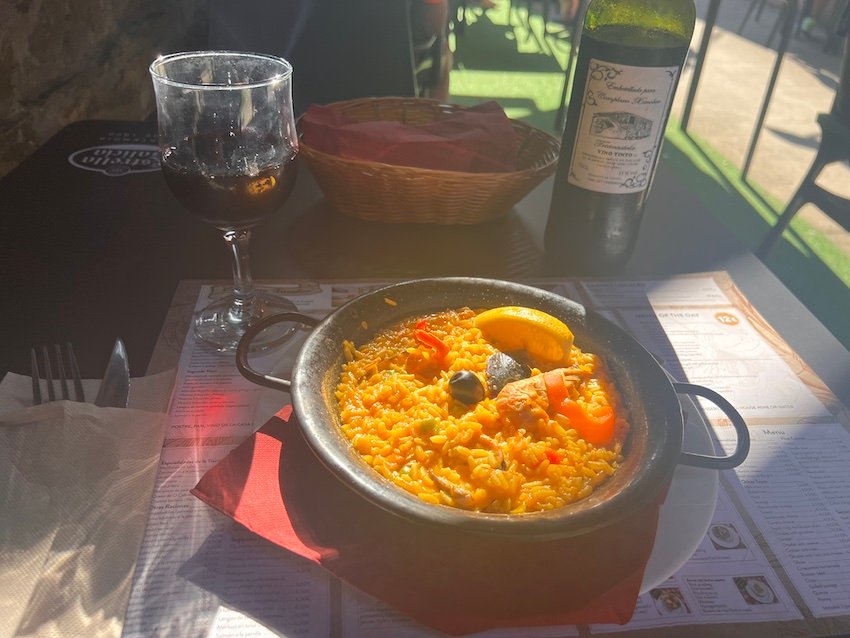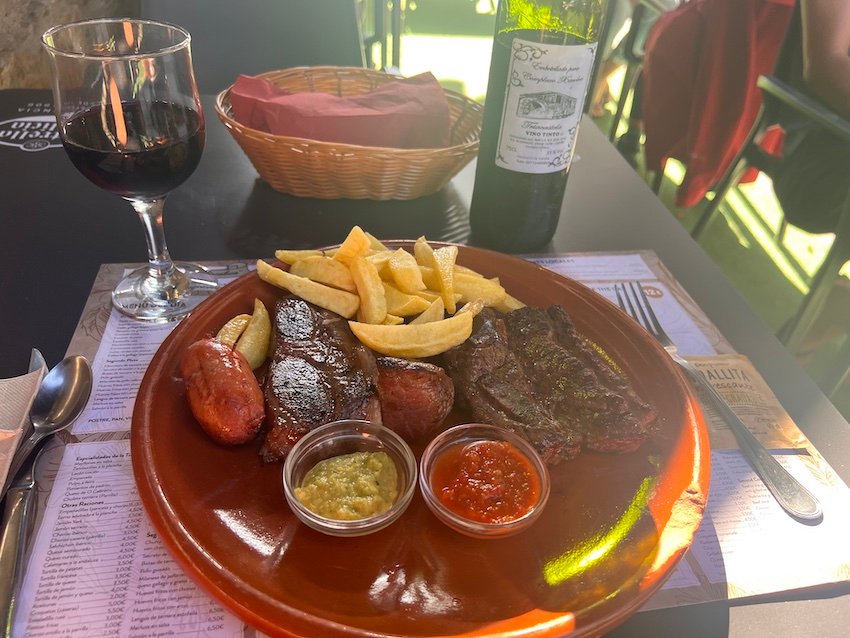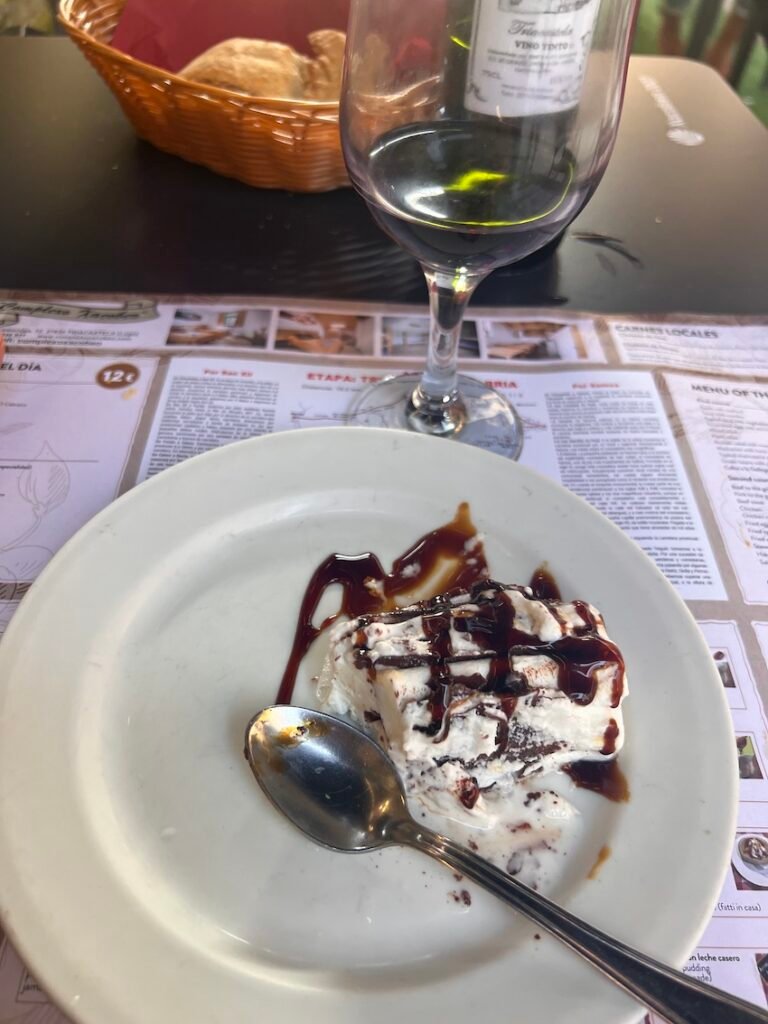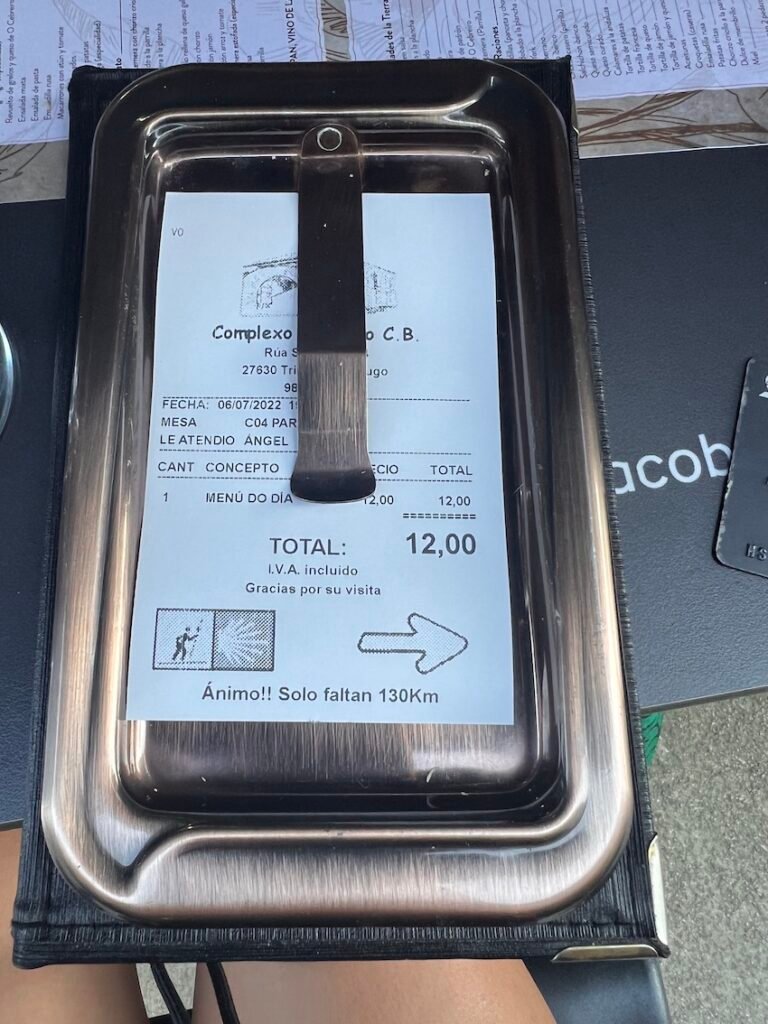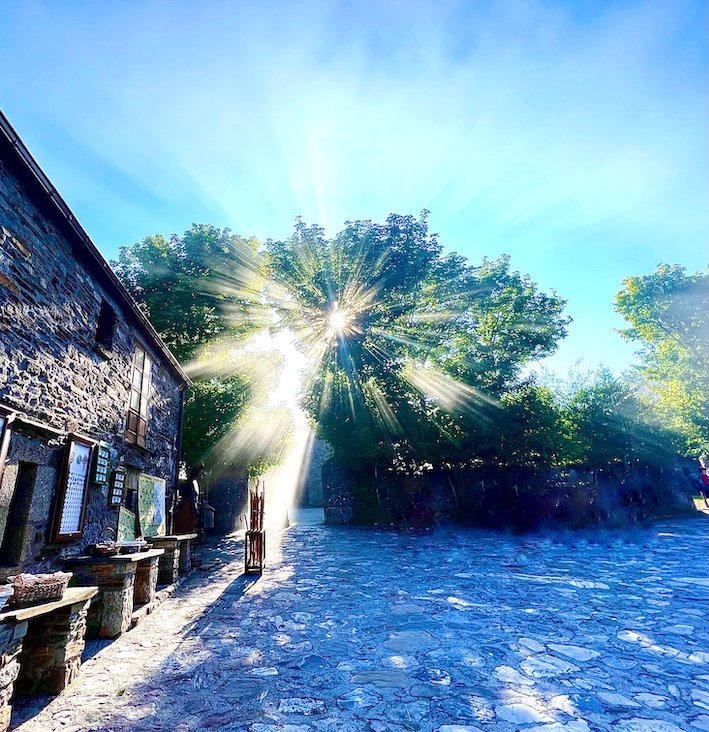Week 4 of my journey to Santiago takes me from Leon into the province of Galicia. As the pilgrimage passes the 500KM mark of the Camino de Santiago; injuries are not uncommon. I battle my own injuries this week and encounter many others who are also trying to overcome their bodily objections to the journey. Along the way, I encounter various Camino legends, and immerse myself in beautiful pastoral scenery prevalent in this section of the Camino.
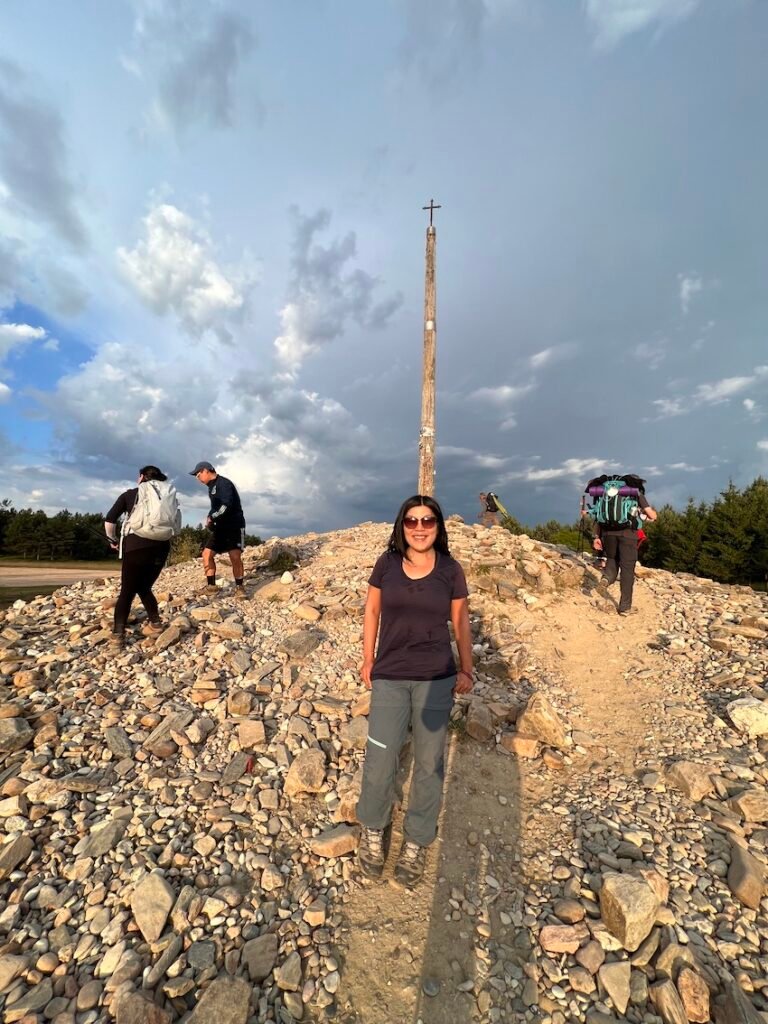
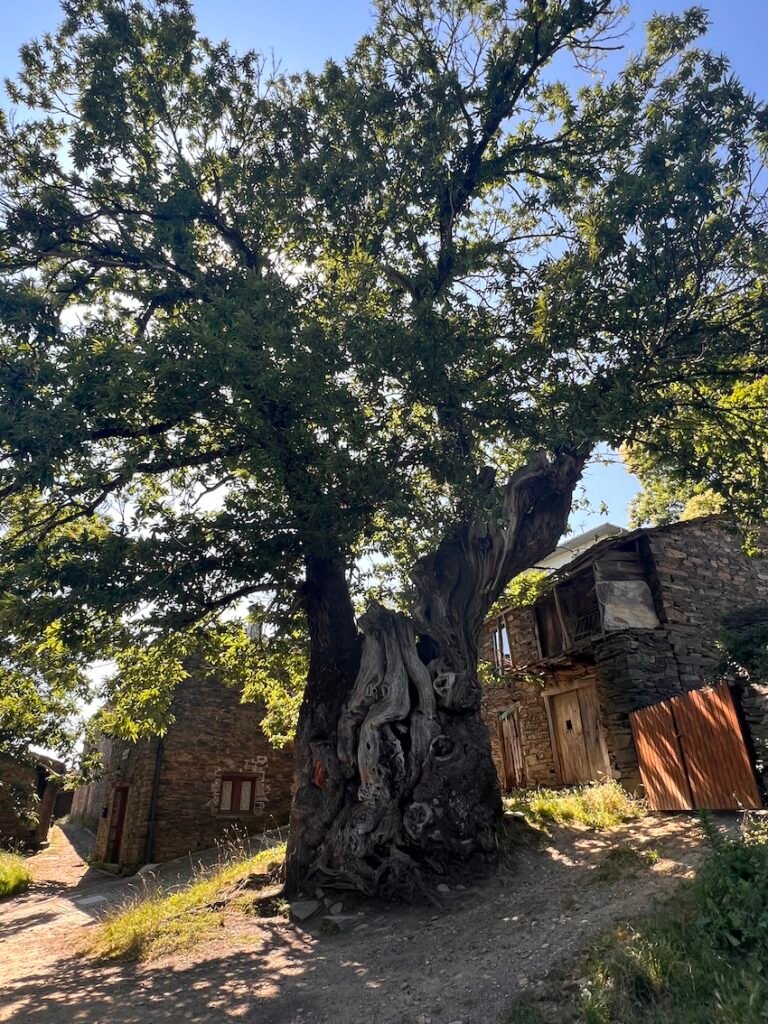
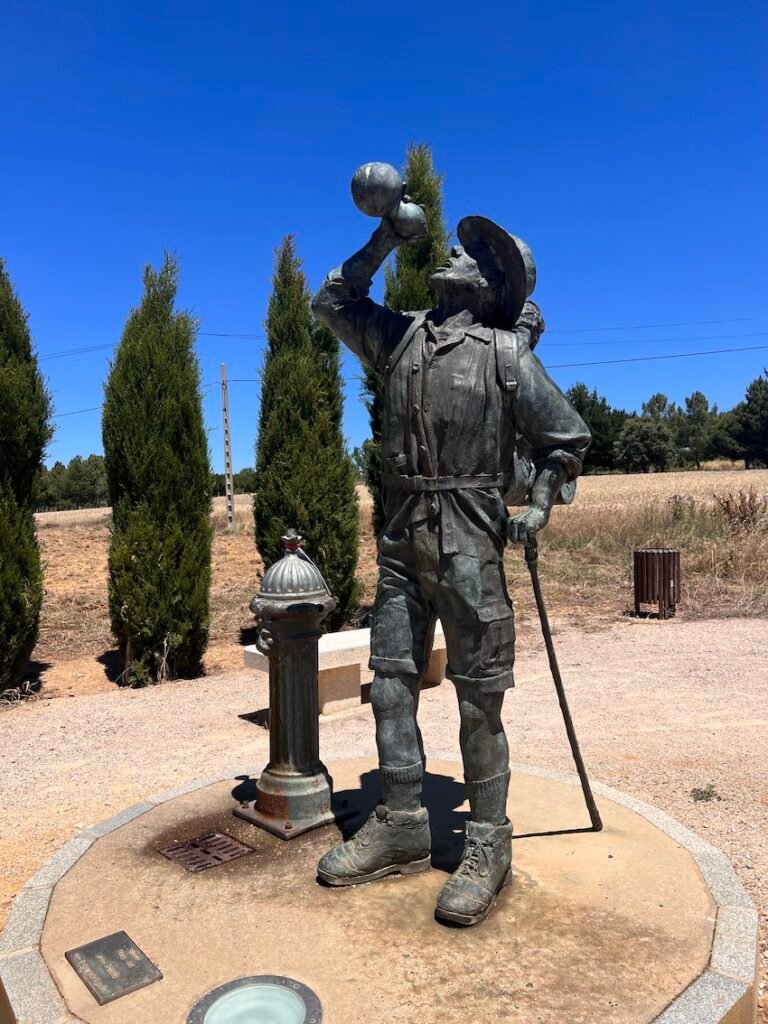
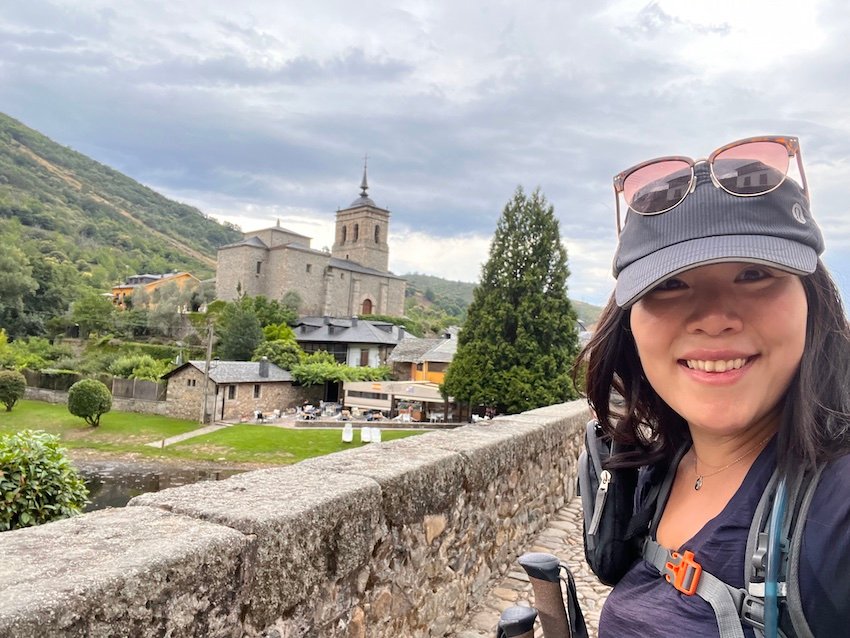
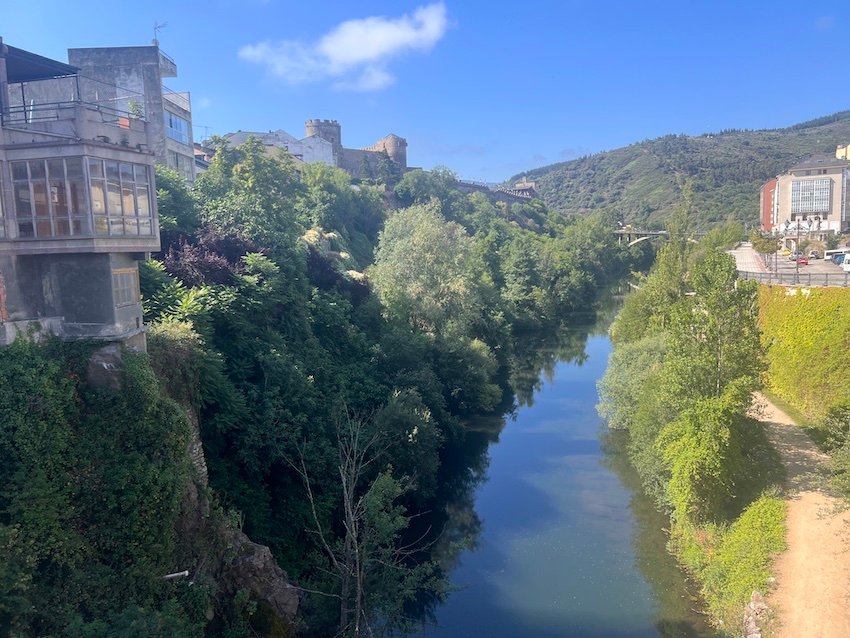
Contents:
- Day 22: Leon to San Martin del Camino
- Day 23: San Martin del Camino to Ashtorga
- Day 24: Ashtorga to Foncebadon
- Day 25: Foncebadon to Ponferrada
- Day 26: Ponferrada to Villafranca del Bierzo
- Day 27: Villafranca del Bierzo to La Faba
- Day 28: La Faba to Triacastela
This post includes affiliate links. If you make a purchase via one of these links, I may receive a small percentage at no extra cost to you.
Day 22: Leon to San Martin del Camino
25KM
9:30am – 4:30pm (1 hour break)
The Camino takes an indirect path through the city of Leon, weaving through narrow streets to take pilgrims past landmarks like the Catheral of Leon. The city’s tall buildings create a shaded walk, but it takes nearly two hours to get out of the city limits. Once we get out of the heritage district of Leon, the route goes through a long industrial zone of Leon before turning into a monotonous and featureless walk along the highway towards San Martin del Camino.
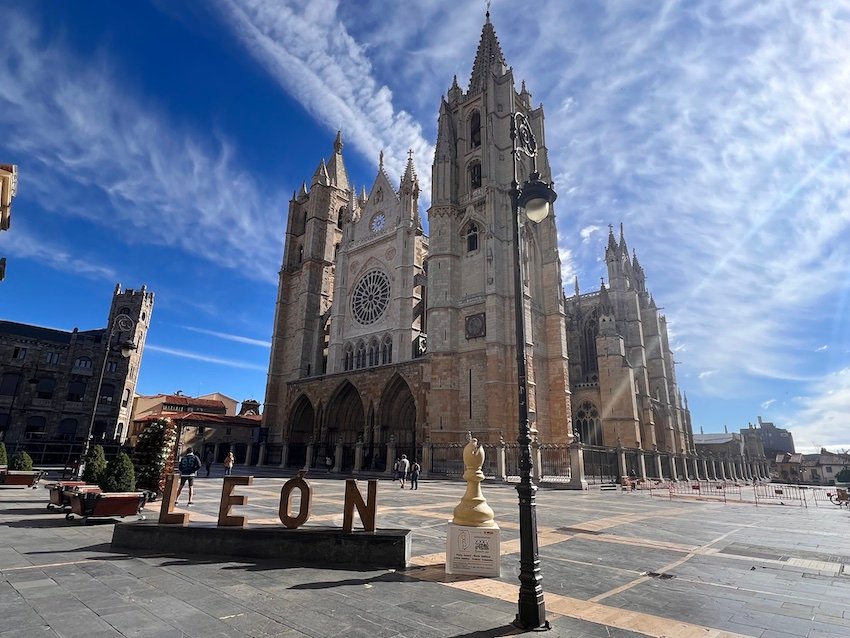
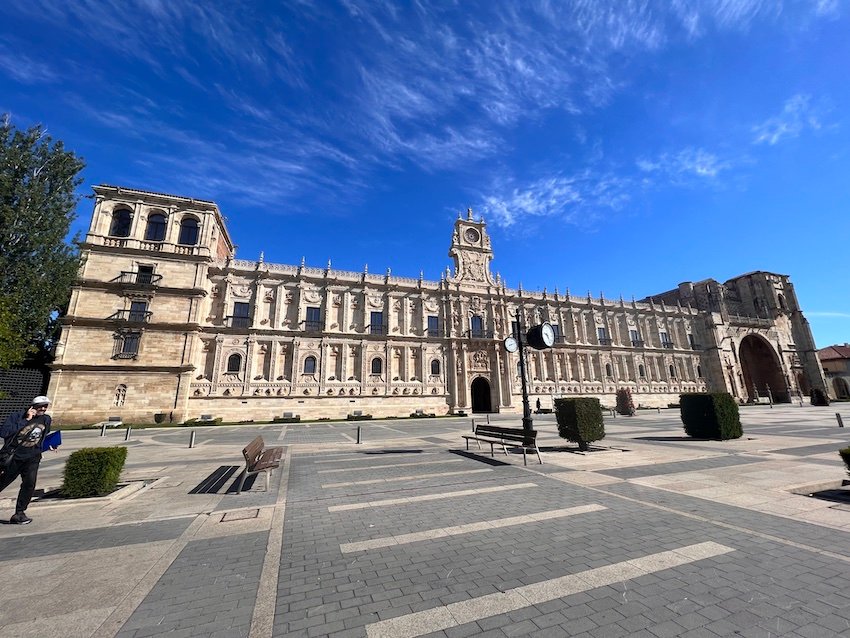
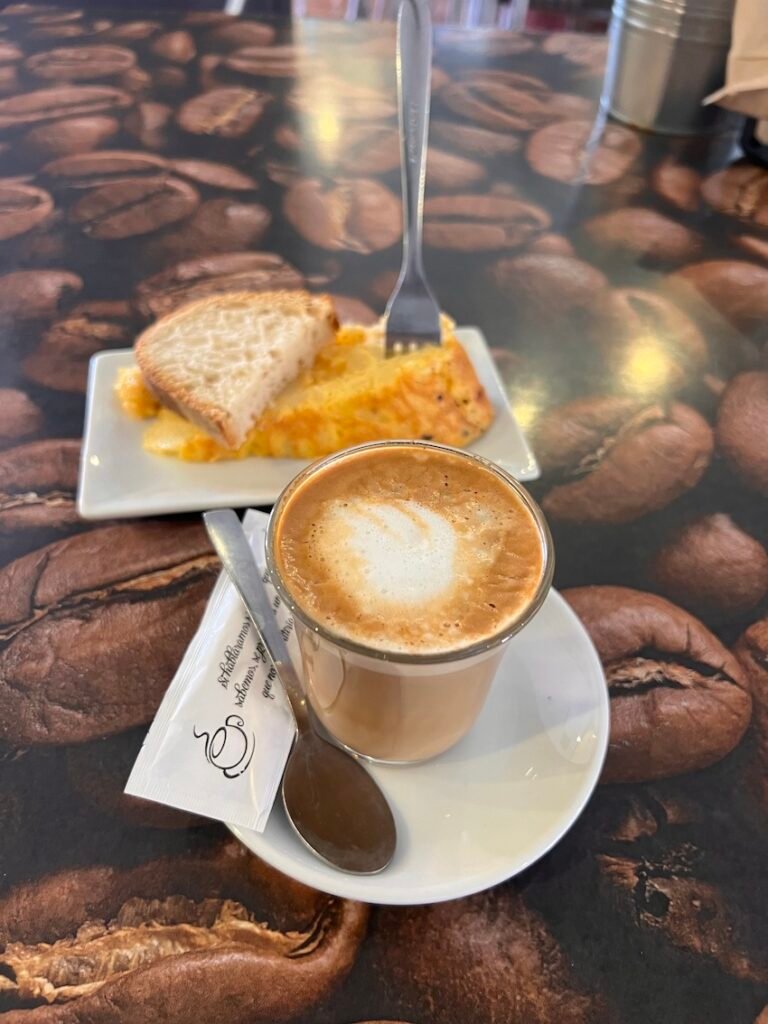
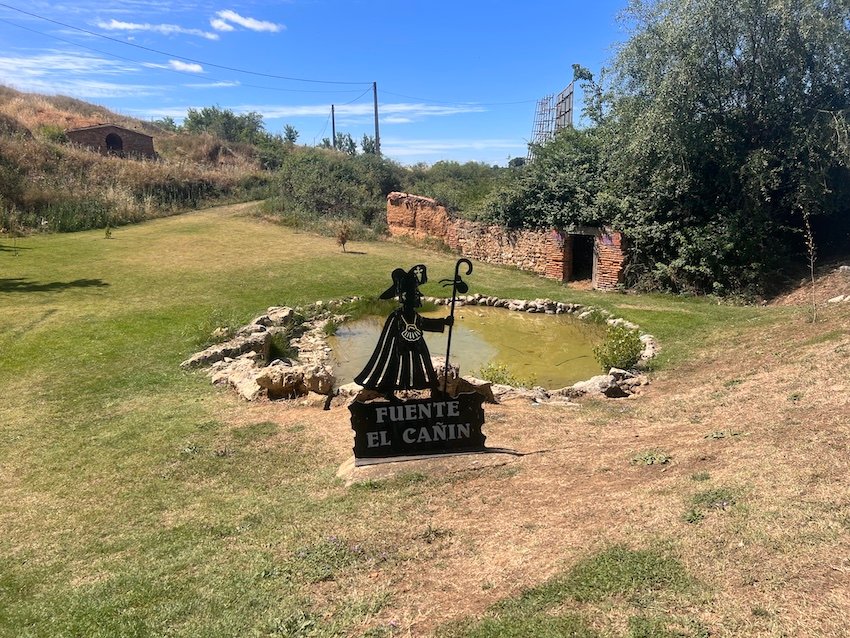
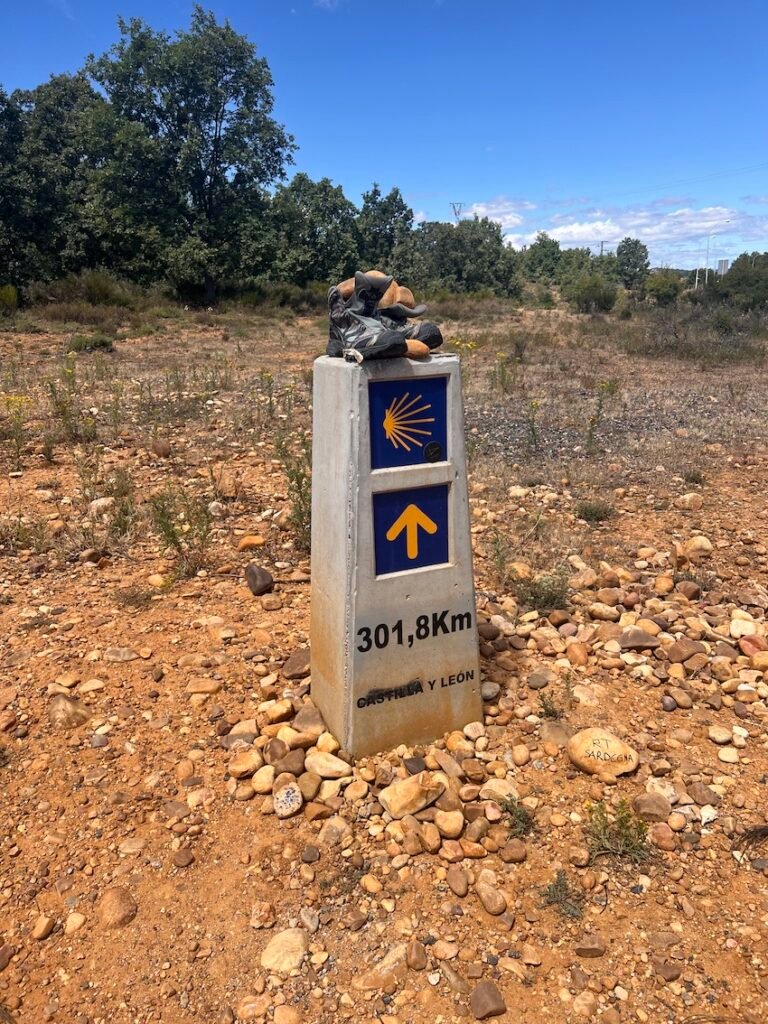
Today is one of the least enjoyable walking days I’ve had thus far on the Camino. I had just left the Meseta behind – which some argue is the worst section of the Camino – but today is by far worse than anything I experienced on the Meseta because the walk is primarily along a path beside a busy highway.
I stay at the Albergue Vieira in the tiny town of San Martin del Camino tonight. The albergue is clean, has a very cold pool, and a great drink selection. I enjoy a lovely home-cooked communal dinner with other pilgrims at the albergue tonight.
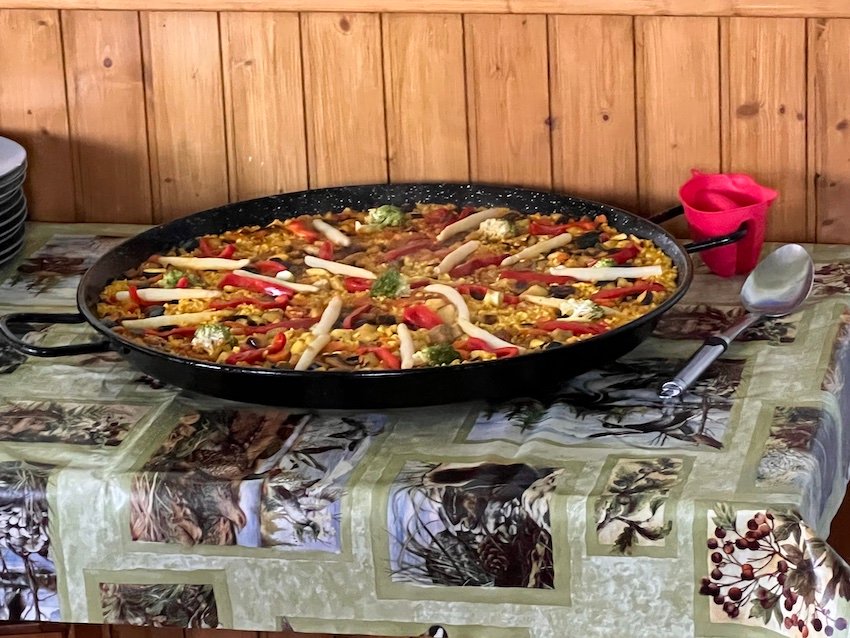
Day 23: San Martin del Camino to Ashtorga
25KM
7:30am – 3:30pm (2 hour break)
I set out towards Ashtorga today. While the day started relatively cool, by the afternoon it was starting to become quite hot. On the 8KM stretch between Santibanez de Valdeiglesias and San Justo de la Vega, there was very little shade along the desolate trail between the two towns. Then, like a mirage in a desert landscape, an Oasis paradise pops into view. A massive table filled with every imaginable fruit, along with cheese, sausage, and chocolate is presented like a heavenly vision. Pilgrims are welcome to take whatever they like for a donation. Cash from donations is laid out freely on the table without any worry of theft. A second stand with “Creas lo que cree” (believe what you believe) written on it, is filled with a huge variety of juices, coffee and pots of yogurt.
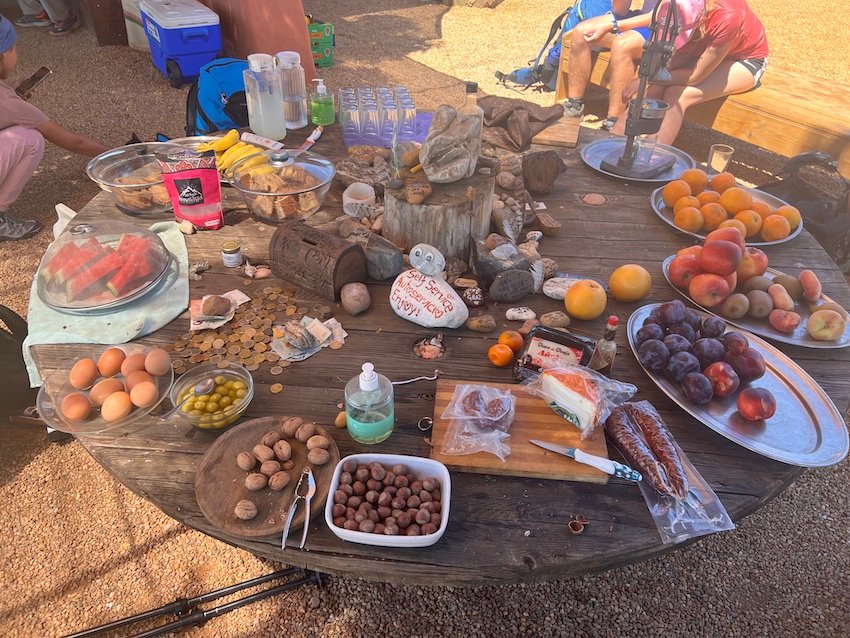
There are hammocks, and comfortable seating all around this shaded little paradise, and one could easily imagine spending hours, or even days here. Underneath one of the benches was a little family of a momma cat and her four kittens. The antics of the adorable kittens could have easily provided hours of entertainment as we enjoyed the delicious food and drink in this gorgeous oasis. The oasis is run by a former pilgrim named “David” who had been running the place for 12 years. He was originally gifted the land, and he wanted to do something charitable to support passing pilgrims in this desolate stretch of the Camino; so he has created this wonderful, and absolutely unforgettable oasis of goodwill and kindness.
I am pretty exhausted by time I get into Astorga. I stayed at the municipal albergue in Ashtorga. This is a huge albergue with over 150 beds. As one of the later arrivals, I was on the 3rd floor of the building. The albergue has an excellent kitchen and a fantastic terrace. I meet Dustin – a fellow Canadian in his 30s from the Toronto area. He’s using vacation time to do the Camino so was limited to less than 30 days to do the trek. He had heard from a friend that she did the Camino in 20 days and thought he could do it in a similar amount of time. My jaw dropped when he told me this and he quickly added that it has obviously not worked out so well for him – judging from his limp.
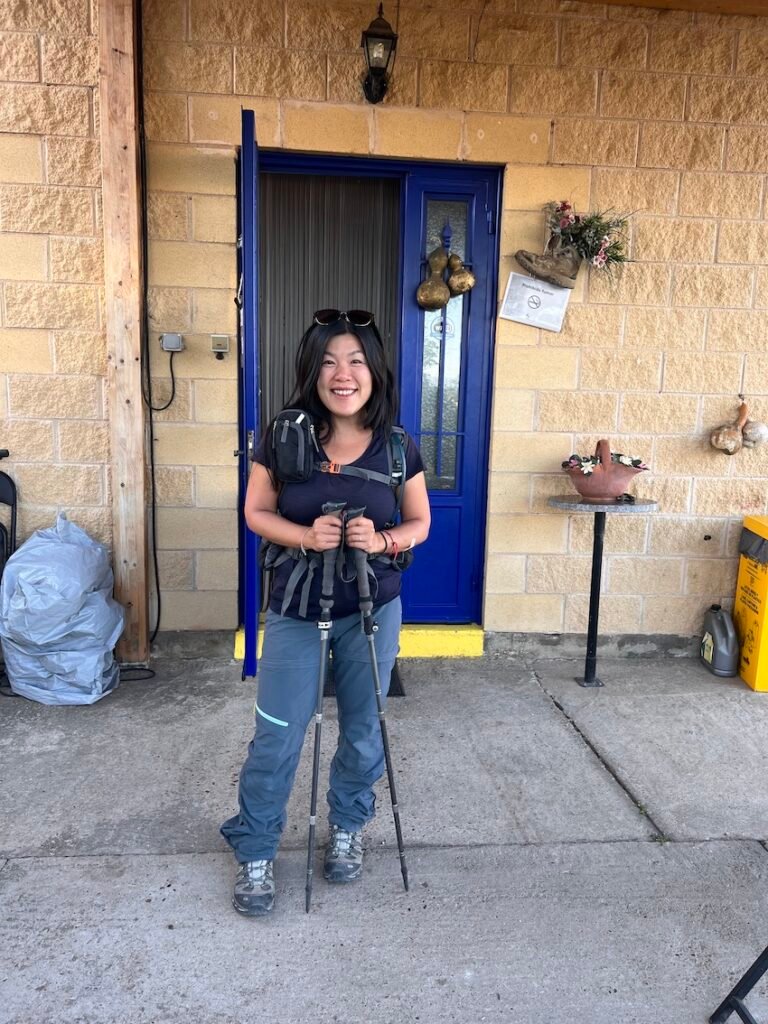
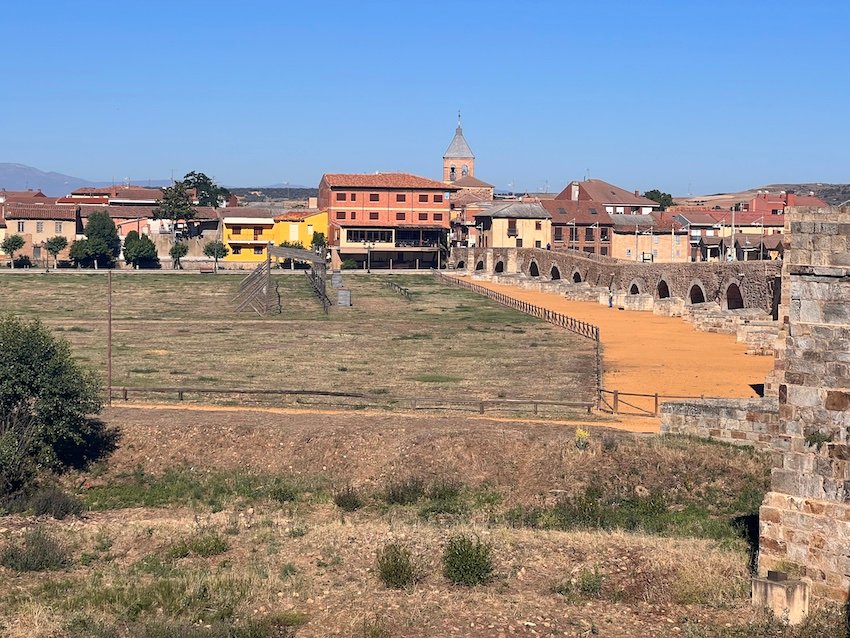

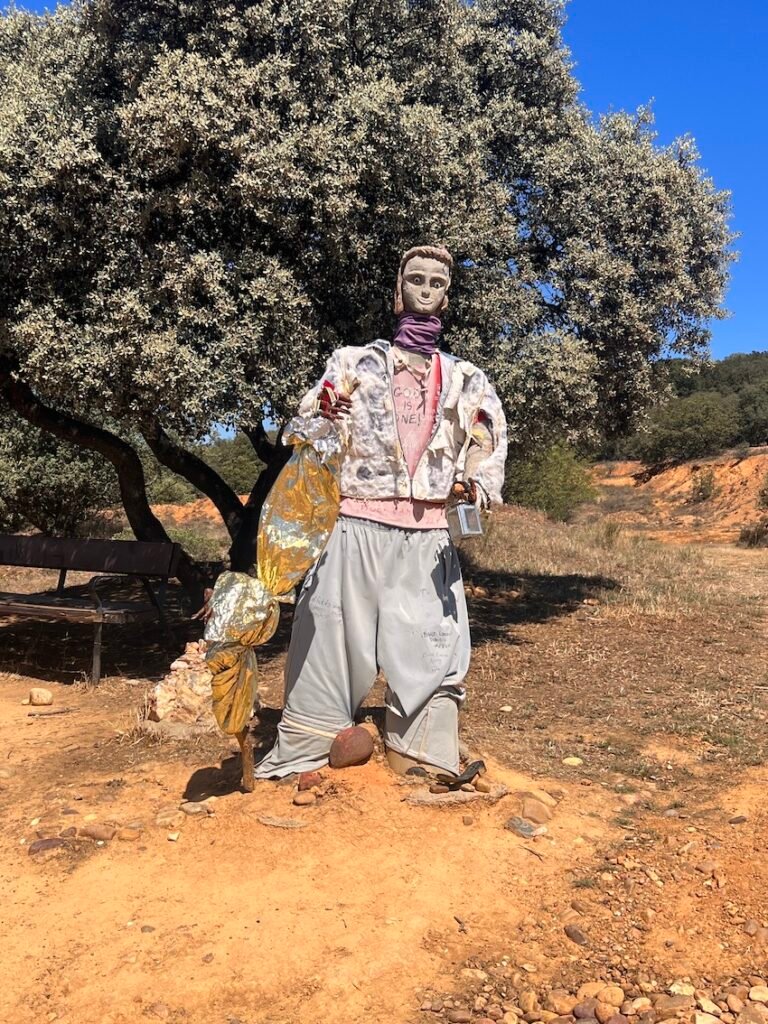
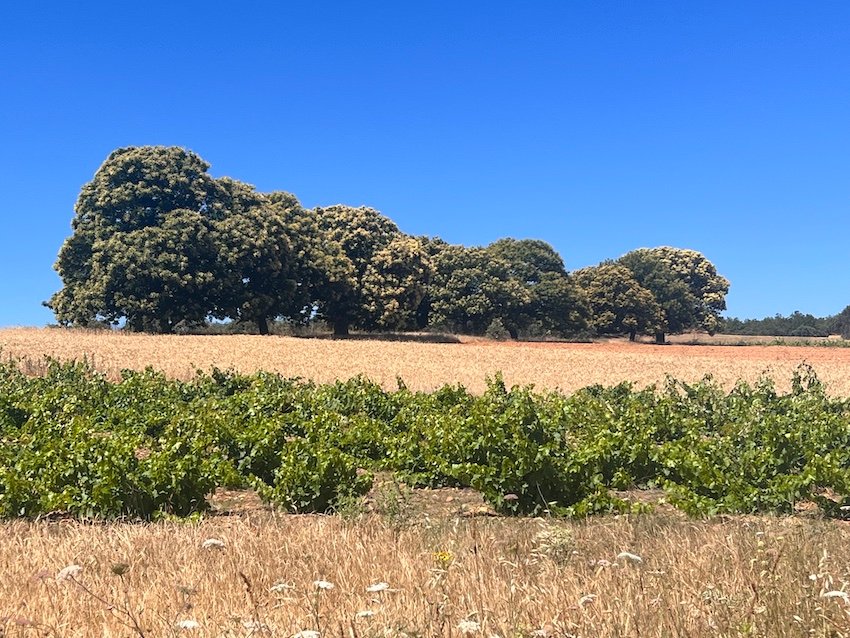
“What happened?” I asked. Dustin, who is obviously very fit, judging from the ultramarathon race shirt he’s wearing, was basically doing two stages a day – about 50km a day – or more than a marathon a day – for the first week or so, and then the horrific blisters he had developed from this inhuman pace basically stopped him in his tracks. “I walked out one morning, took ten steps, and realized that I was not going to be able to walk any further,” he said with a tinge of regret in his voice. He ended up taking a bus between Burgos and Leon, skipping the Meseta in order to make up the time that he lost in recovery and also in order to accommodate a more normal pace.
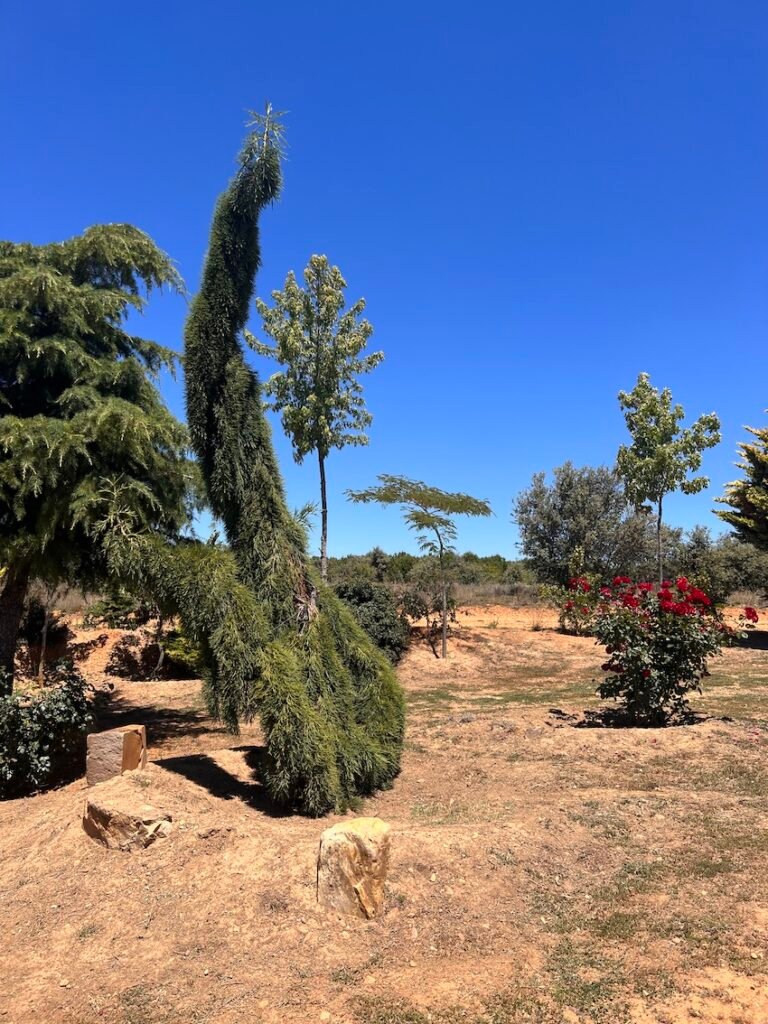
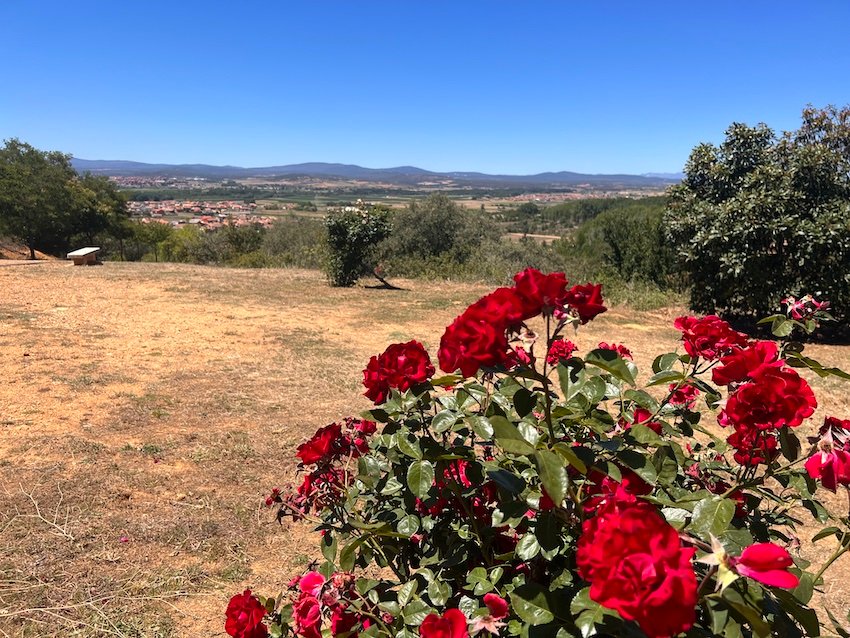
One constant that has become abundantly clear to me during this Camino journey is that no matter how fit you are – never, ever underestimate the pilgrimage. In my 20 days or so, I’ve seen some of the fittest, strongest people bow out of the Camino de Santiago from unexpected injuries – often due to underestimating the journey.
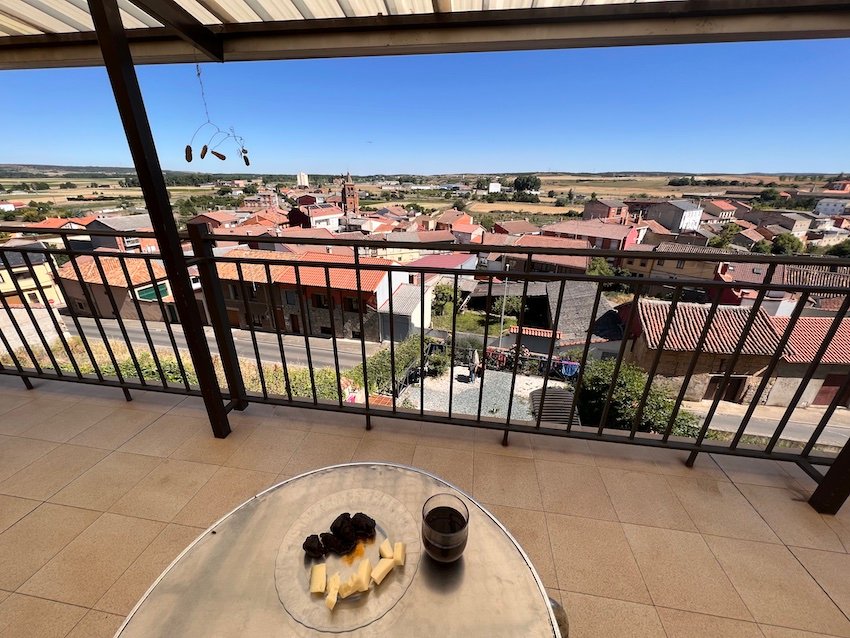

Day 24: Ashtorga to Foncebadon
26KM
7:30am– 4:30pm (2 hour break)
The destination for today is the town of Foncebadon, which has been made infamous by Shirley McLaines book Camino: Journey of the Spirit where she details her Camino journey 20 years earlier. In the book, Foncebadon comes up multiple times. Back in those days, the town was abandoned, and reportedly inhabited by packs of dangerous wild dogs. The idea of passing the town nearly caused her to cancel her Camino altogether. I had done some research into whether Foncebadon was still ruled by packs of wild dogs, and it seems that the town is now a thriving little village full of albergues, bars and restaurants. It was still with some trepidation that I decided to plan a night in this infamous town, as it was the most logical point to stop between Ashtorga and Ponferrada.
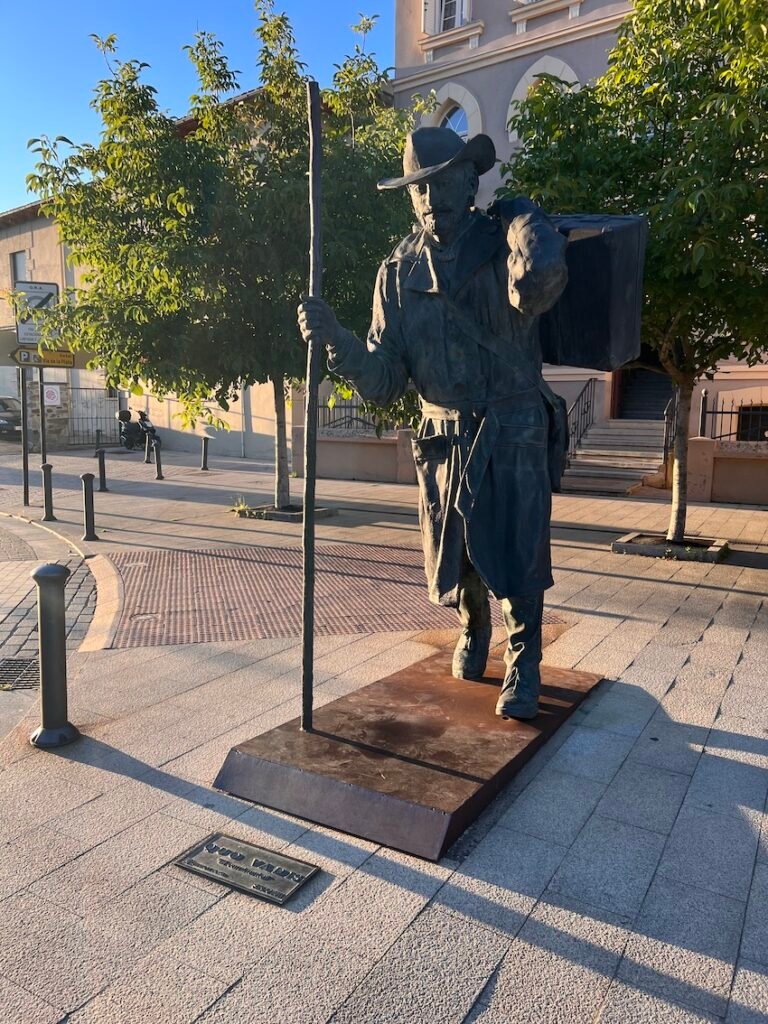
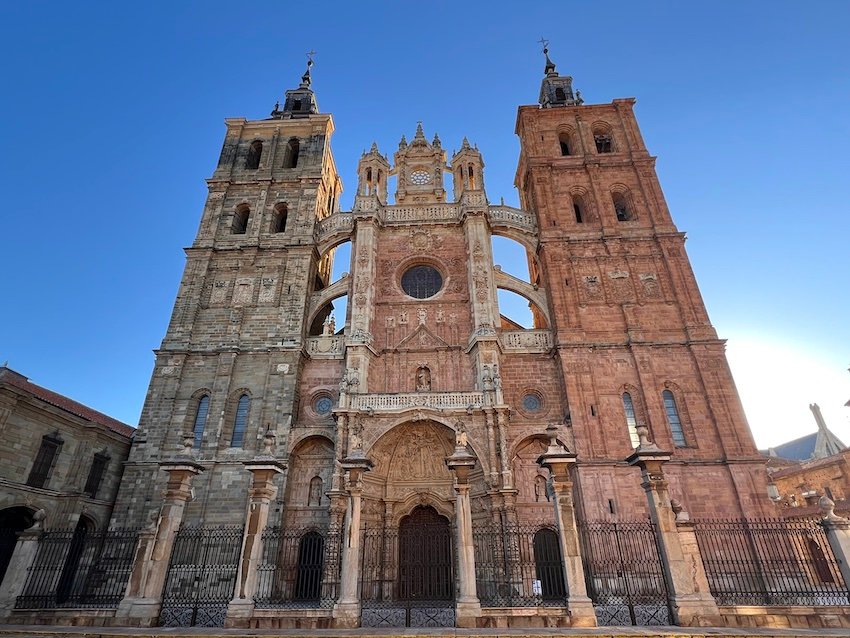
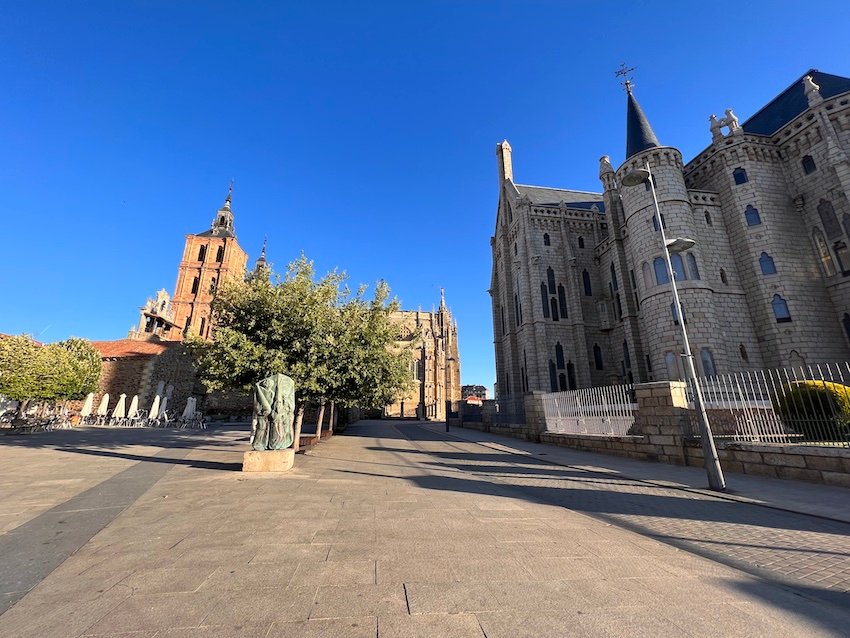
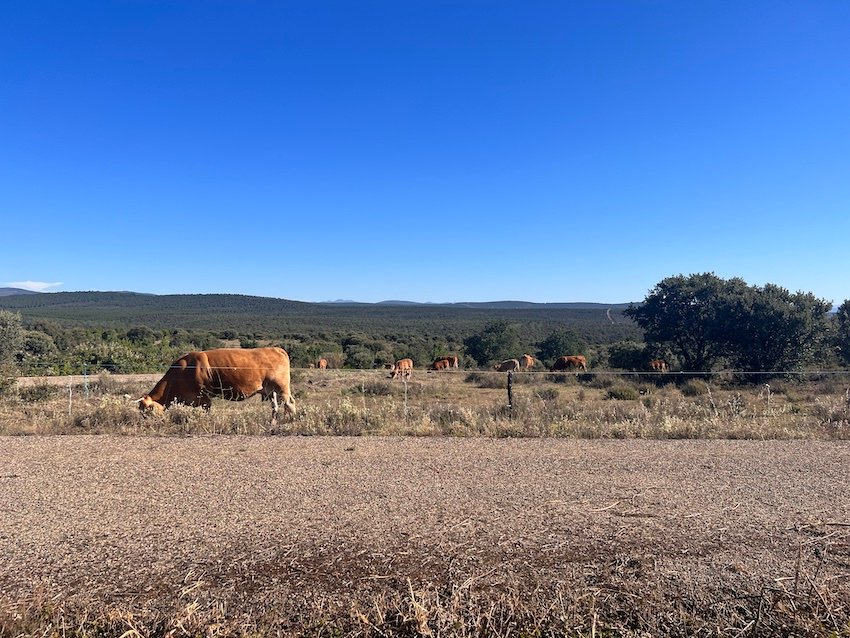
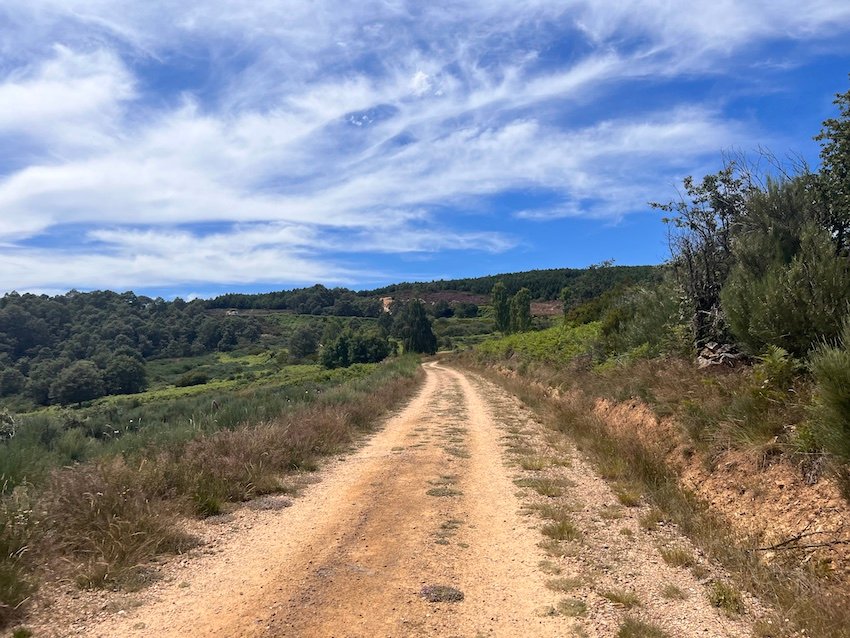
By time I got into Foncebadon in the late afternoon, the albergues were completely full – the only space left was the Parish donativo which thankfully did not turn us away. They found some space for us in an atrium with some sleeping mats, so that was great. My left shin however, was not doing so great – it was sore and swollen. I hoped it would go away soon.


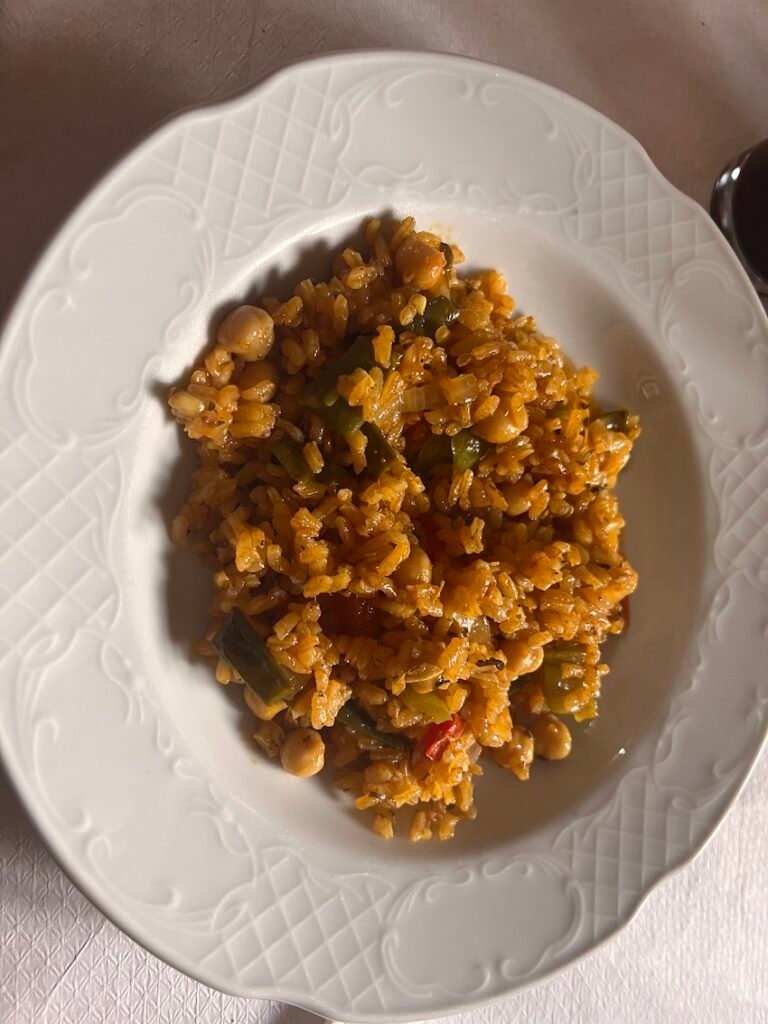
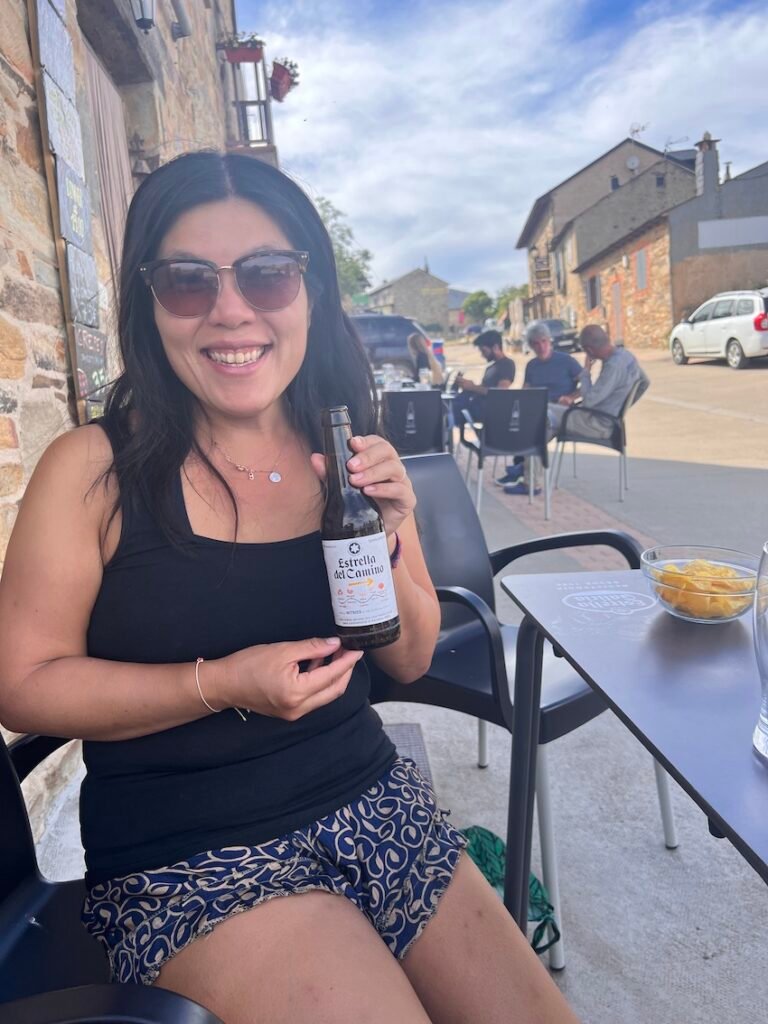
I was beginning to think the whole idea that Foncebadon was once ruled by wild dogs was complete myth until I saw a very old, lion-sized stray dog limp by our dinner table on the street. This dog looked like an extremely old version of the terrifyingly large dog described in The Only Way is West by Bradley Chermside when he walked the Camino some years ago. Perhaps the legend surrounding Foncebadon was true after-all.
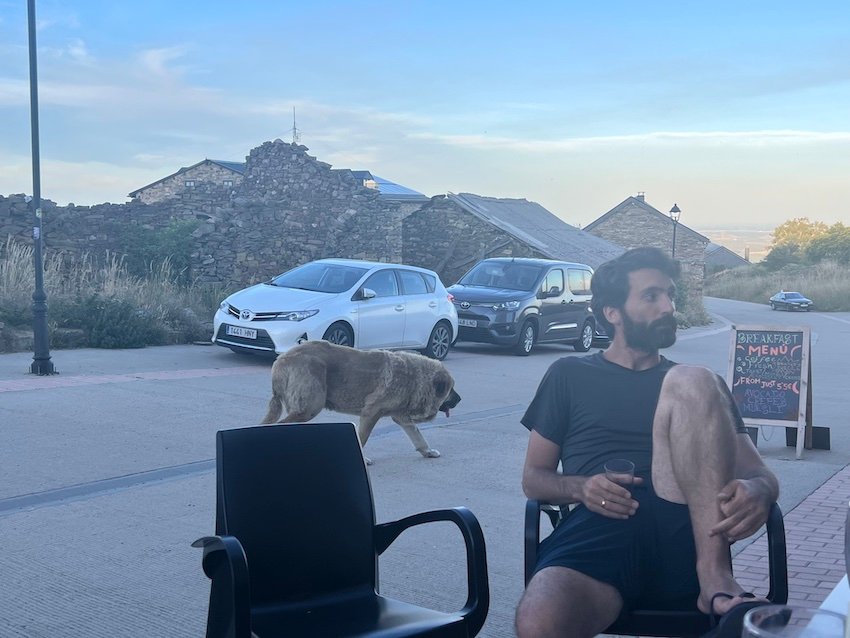
Day 25: Foncebadon to Ponferrada
27KM
7:30am – 3:30pm (1 hour break)
I had breakfast at the parish before heading out behind a giant procession of teenagers making their way out of town. Many school groups complete the last 100KM of the Camino in order to get their Compostela. In Spain, it’s good to have the Compostela on your resume! The same is true for Korea – which is why there are also many Koreans on the Camino.
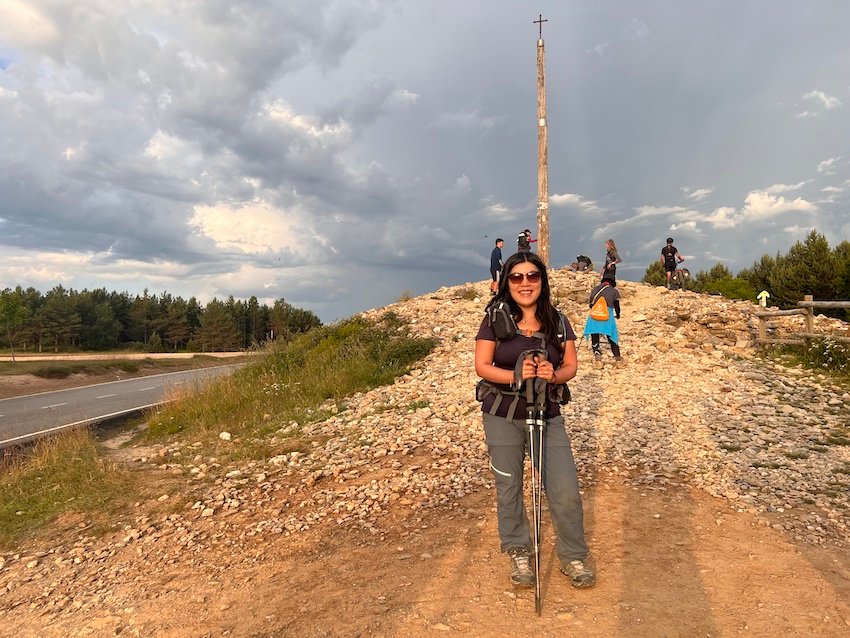
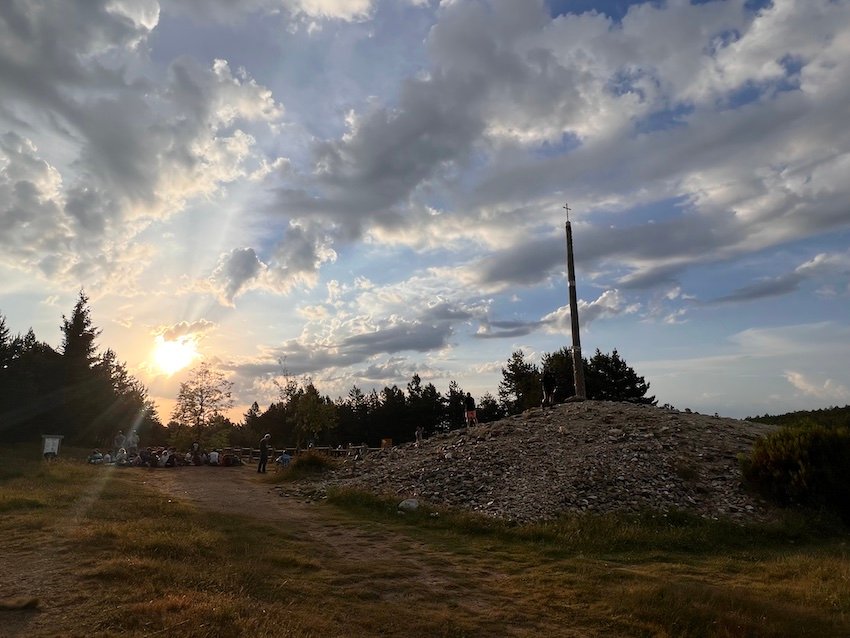
Today we pass the Cruz the Ferro. Here it is said that if you bring a stone from your homeland, and carry it on the Camino to the Cruz de Ferro, you can leave the stone at the cross and make a wish to unburden yourself of whatever burden – physical or spiritual – that you wish.
Descending nearly 1000 meters into Molinseca is brutal, combined with occasional thunder, lightening and downpours, this was one of the tougher days on the Camino. I see a branch of lightening strike one of the mountainous areas some distance away and wonder if I should be worried that I am using metal hiking poles.
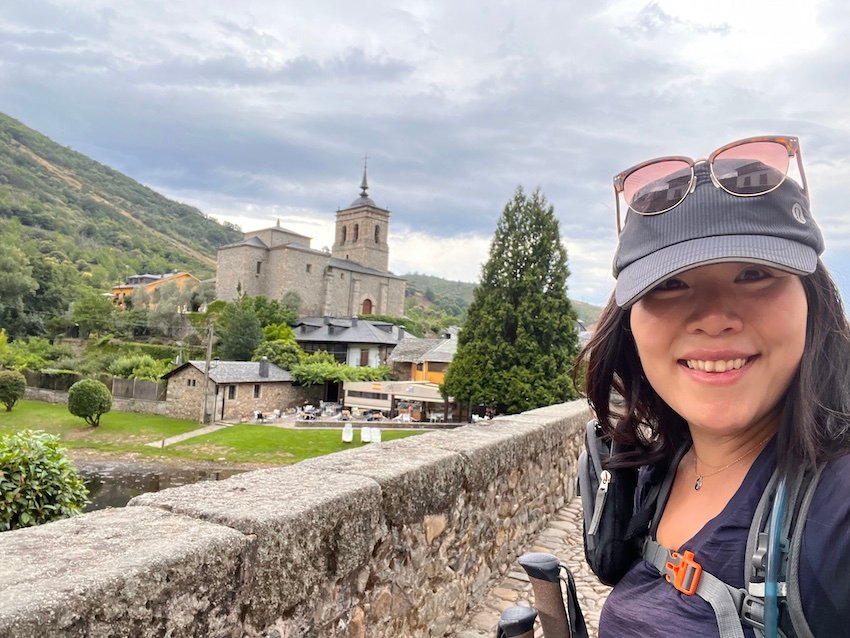
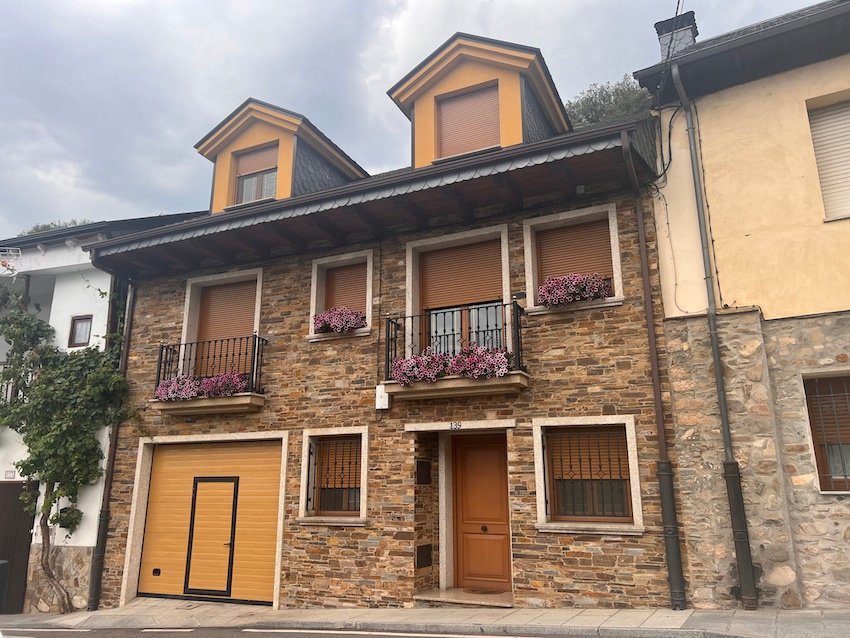
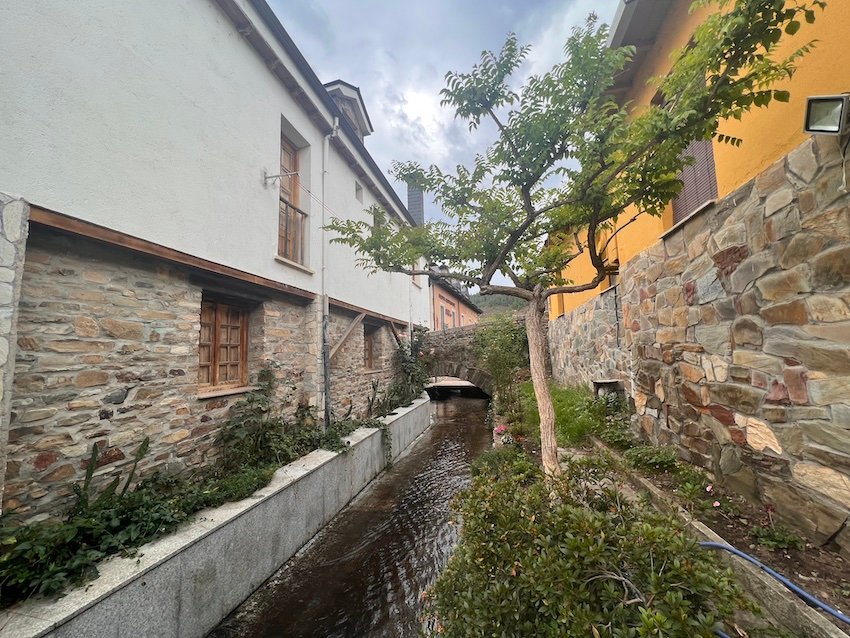
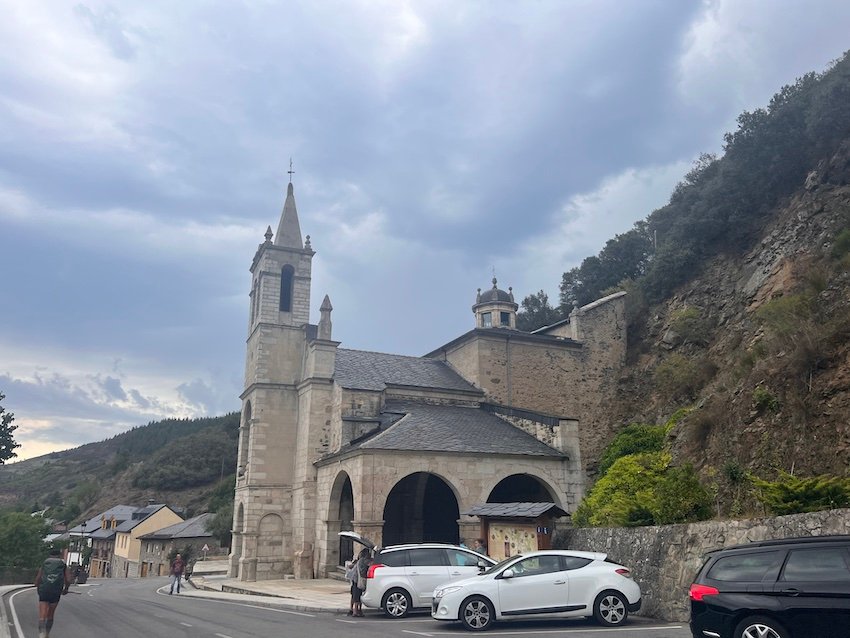
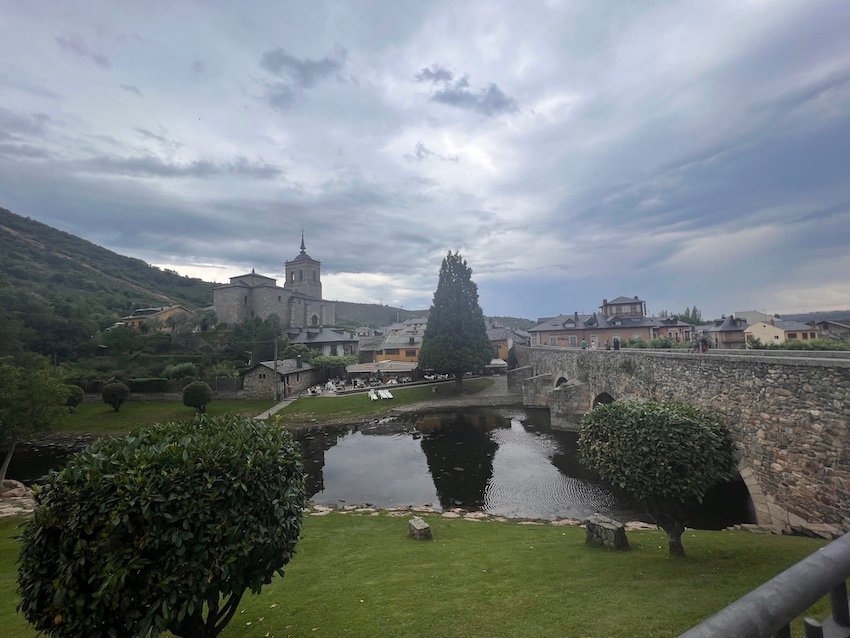
I splurged on a private room at AC Ponferrada Hotel tonight, and arrive looking like a wet dog. The receptionist was sympathetic as she hands me a key to a free upgraded suite. I immediately go up to the room and inwardly pray there’s a bath-tub. There is! The first thing I do is put on a bath. It is heavenly to soak in a hot bubble bath after the hard hike in the rain.
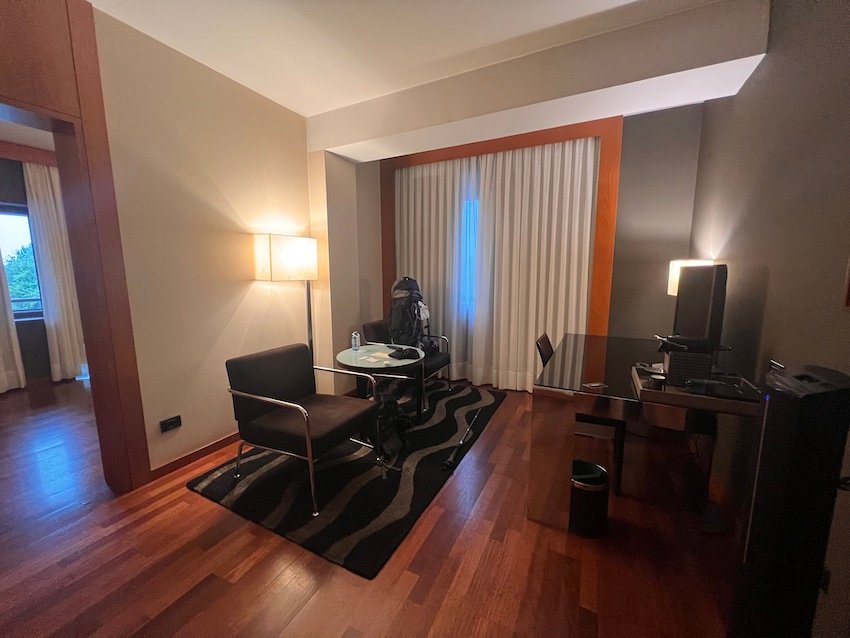
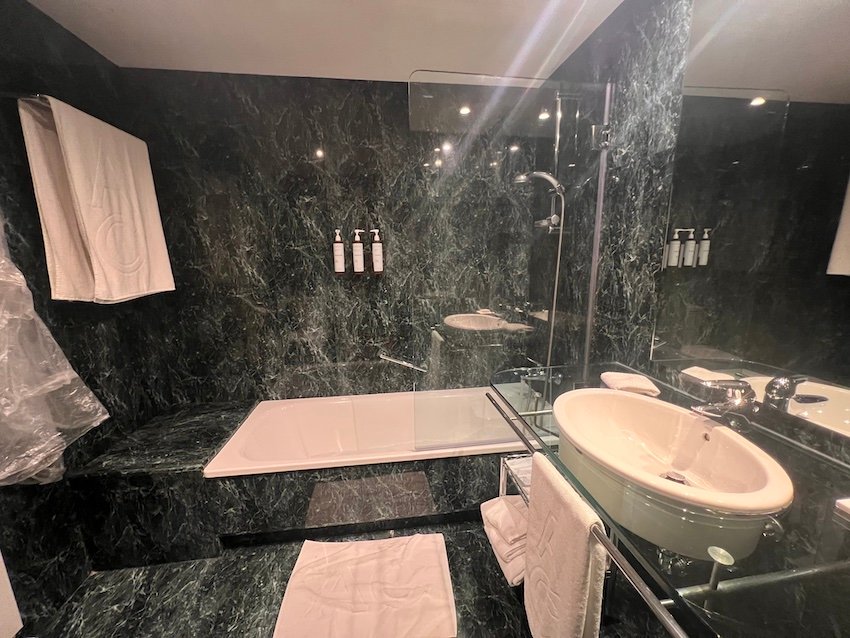

Here comes the hard part: it’s 5pm, and I need to find food. Now, many of you (not from Spain) might be thinking “What’s the problem?” In most places around the world finding food, or a restaurant at 5pm, is not a problem, but here in Spain, especially outside of big centers like Madrid and Barcelona, finding food between the hours of 3pm – 8pm, can be nearly impossible.
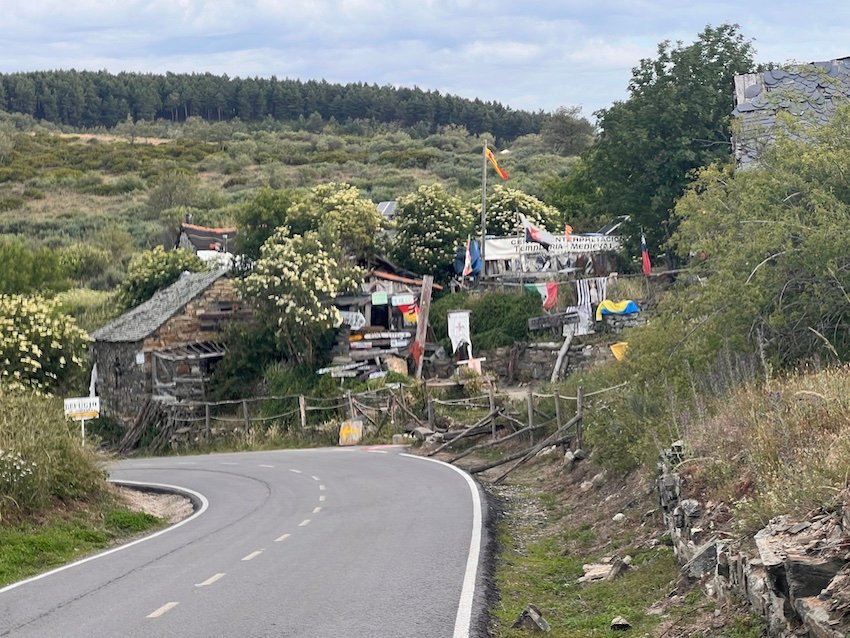
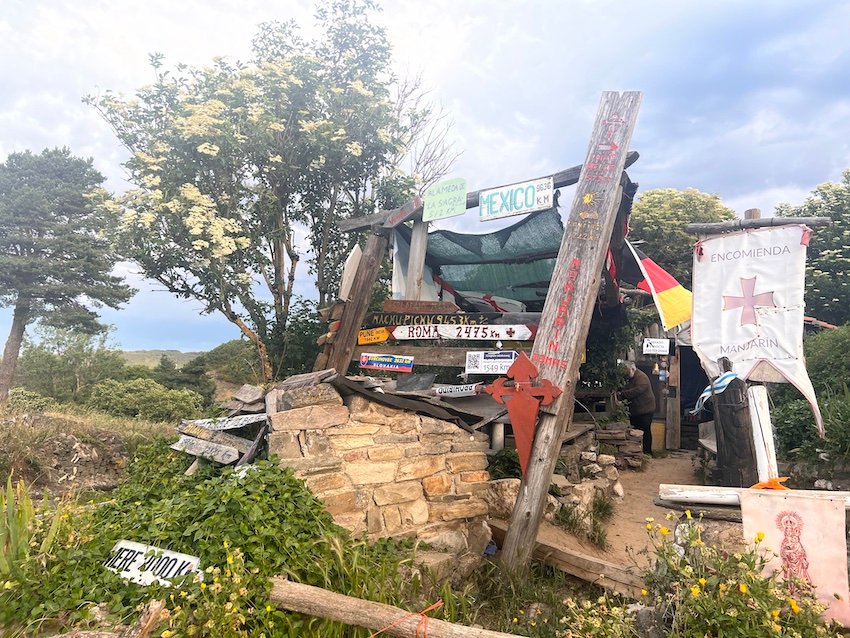
It’s Sunday today, so my fallback routine of getting something at a grocery store is also not possible, because it seems all the grocery stores are also closed on Sunday – even the big supermarket chains like Lidl and Dia – in addition to most of the restaurants!
I walk by a place called “La Peregrina” which I initially thought was a tourist trap, but turned out to be a pretty nice bar, as well as supermarket, and gas-station all rolled into one! The layout was done so that the three sections of this complex are well separated so you don’t feel like you’re sitting in a supermarket-gas station when you’re in the cafe. I was just grateful to get some food in my belly.
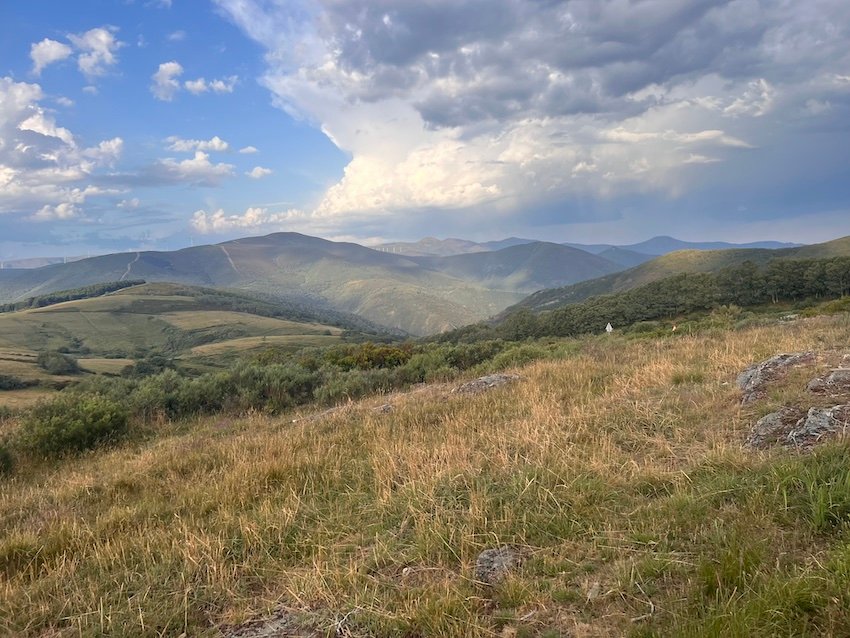
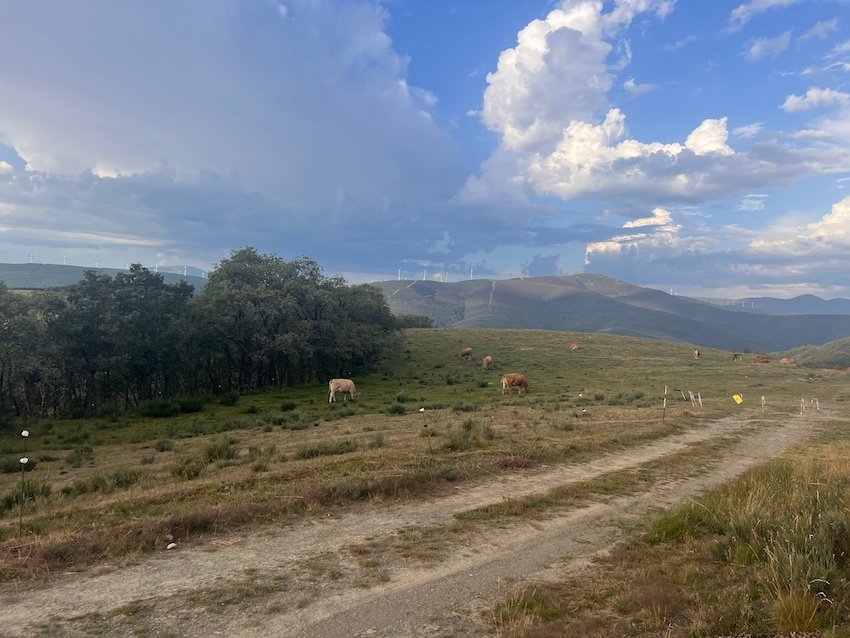
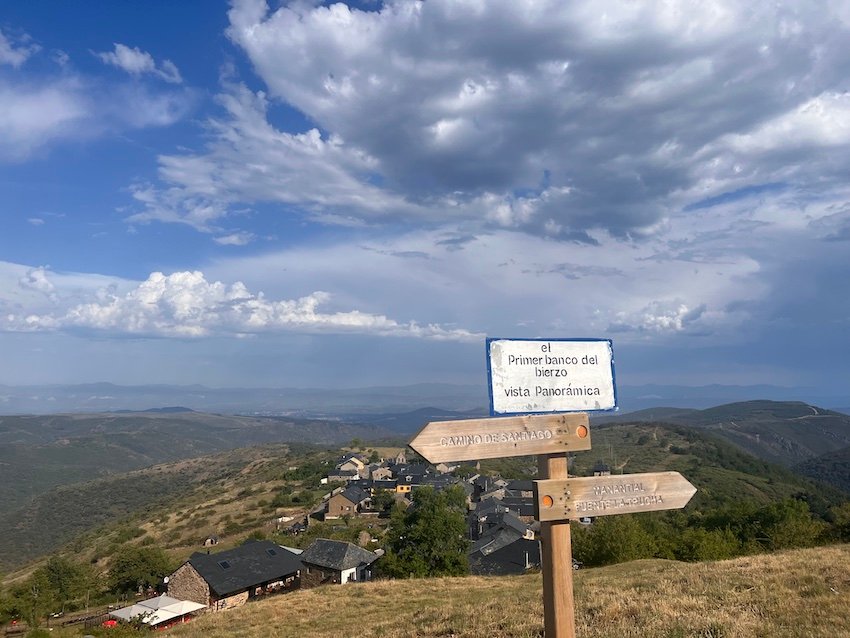
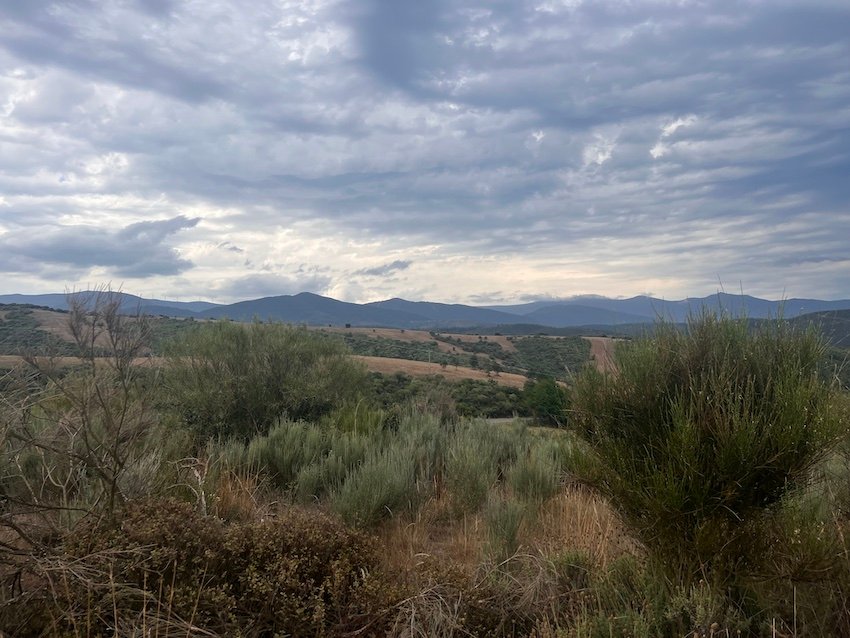
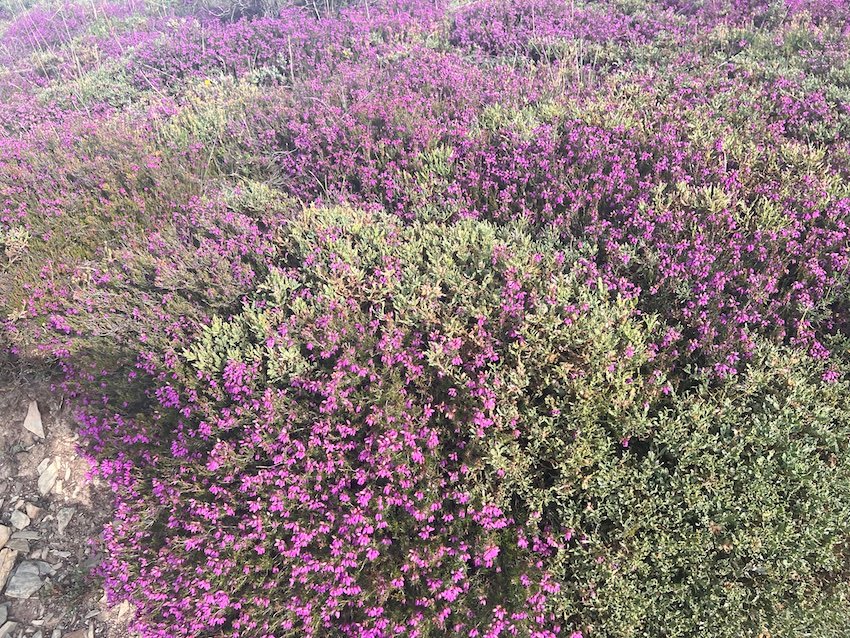
Day 26: Ponferrada to Villafranca del Bierzo
23KM
10:30am – 6:30pm (2 hour break)
My left shin is still quite swollen in the morning despite icing it in the evening the night before. There was still some ice leftover in the fridge and I tie the bag to my shin in the morning as I get ready to see if I can get the swelling down further before starting off on the hike at the record late hour of 10:30am.
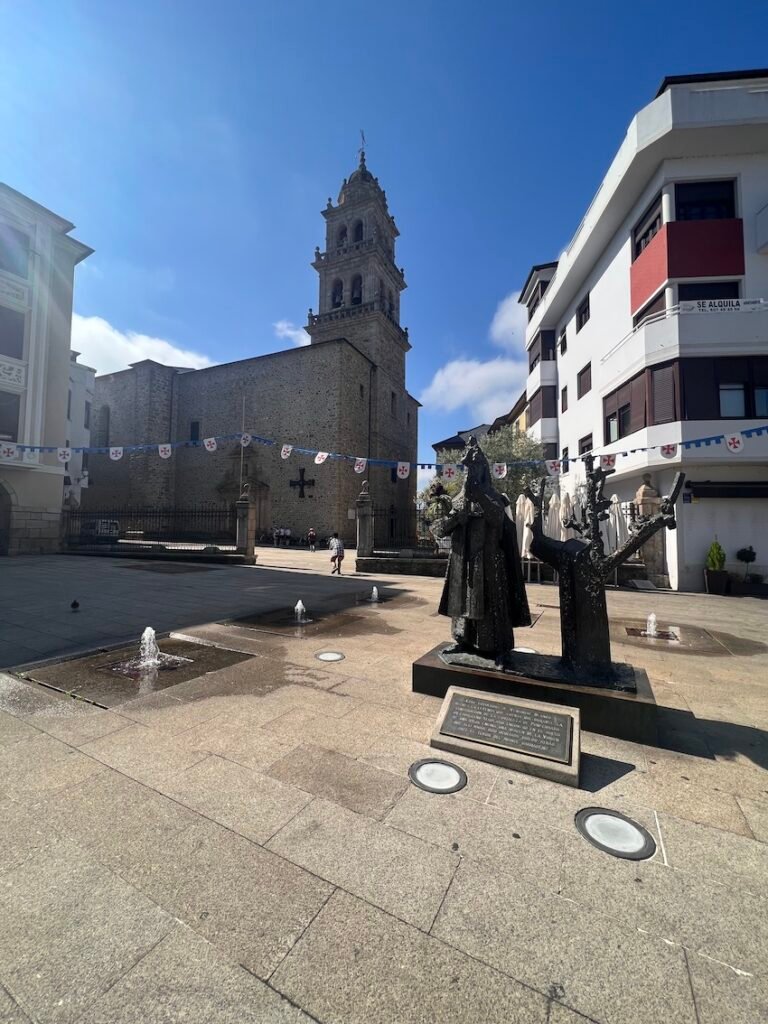


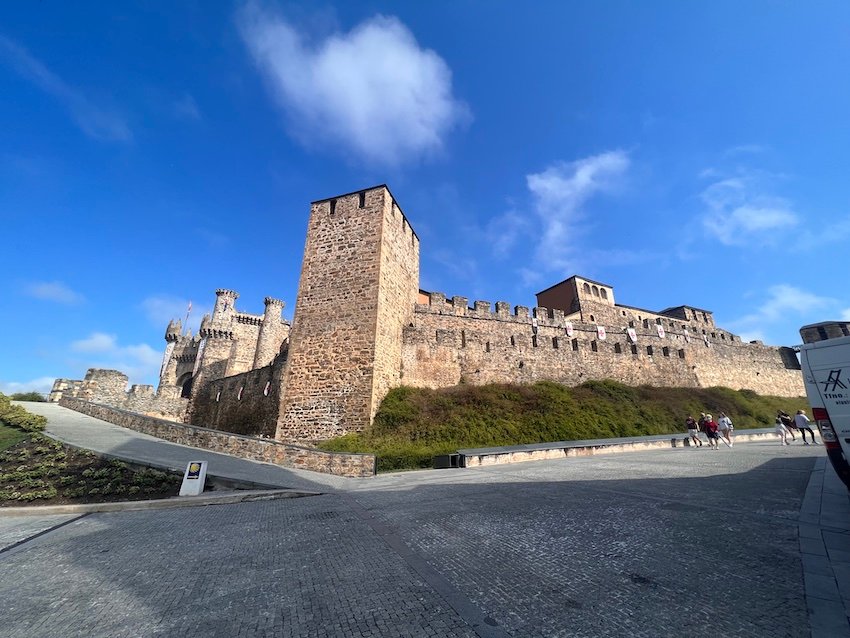
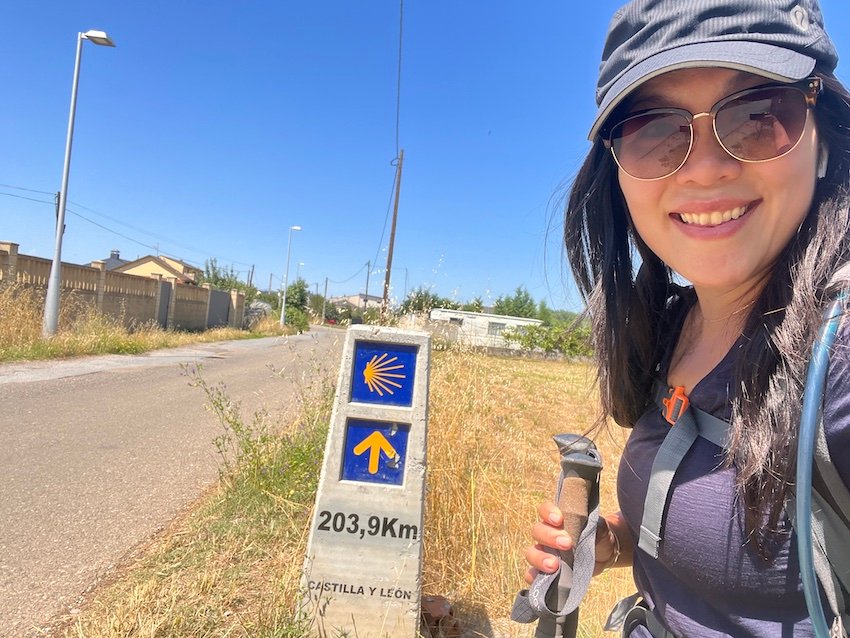
The day is hot quite early, so I need to take frequent breaks. I end up drinking over 3 litres of water today. While earlier sections of the hike today included some awful sections of highway; walking the route as you approach Villafranca del Bierzo is gloriously beautiful as you hike among the vineyards. The vineyard route is more physically challenging though with a number of climbs to reach some beautiful vistas – but I felt it was well worth it even being as tired as I was.
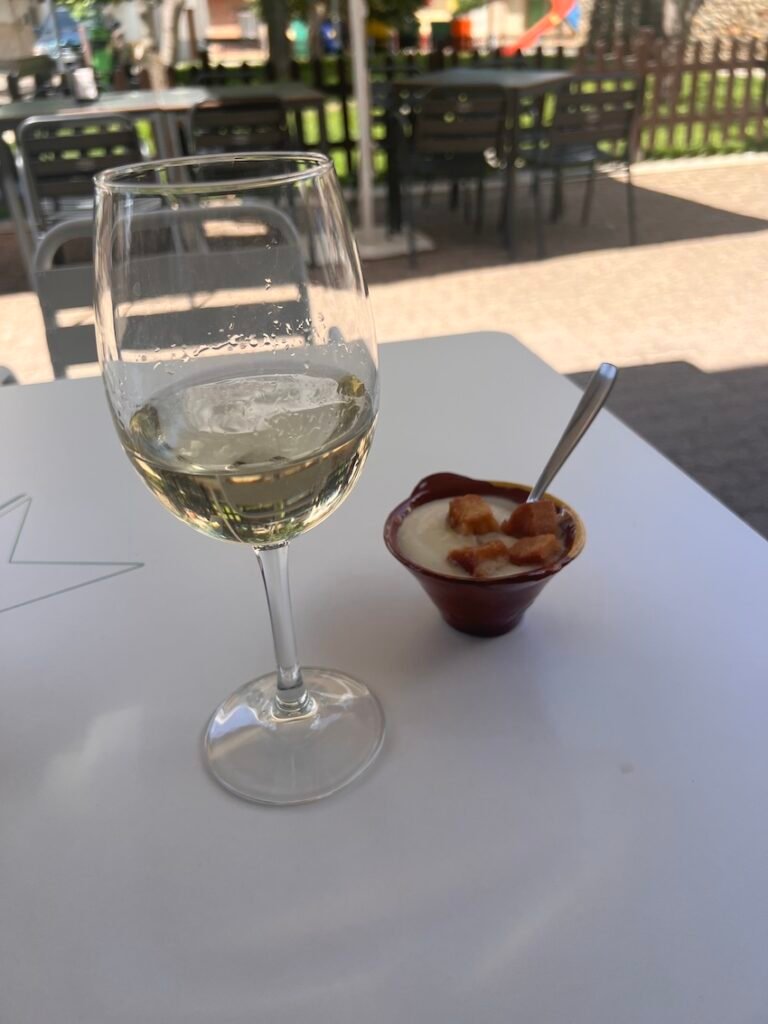
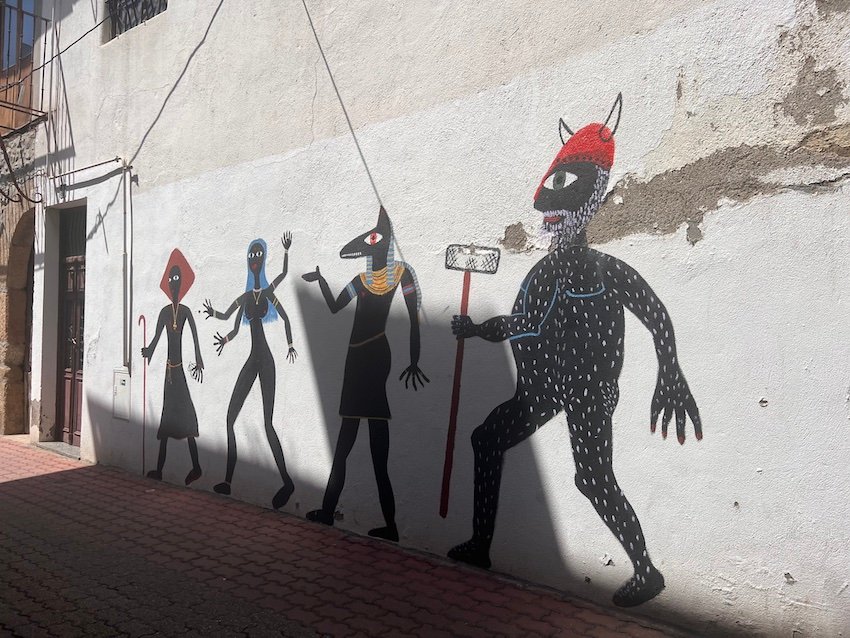
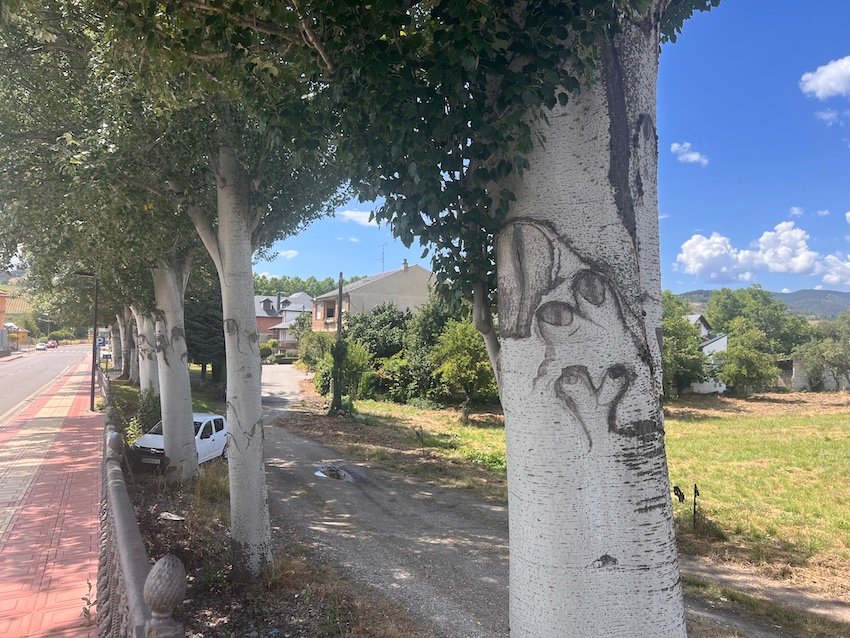
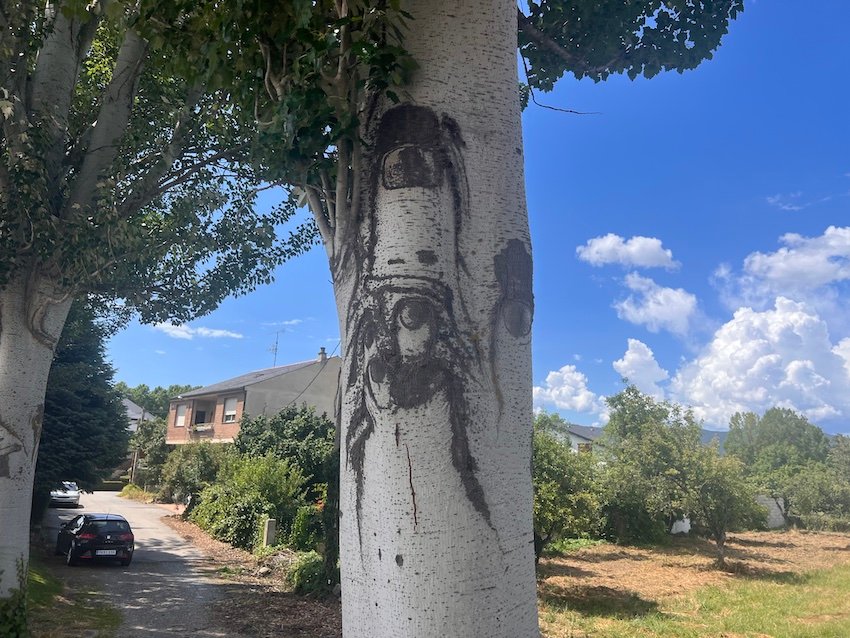
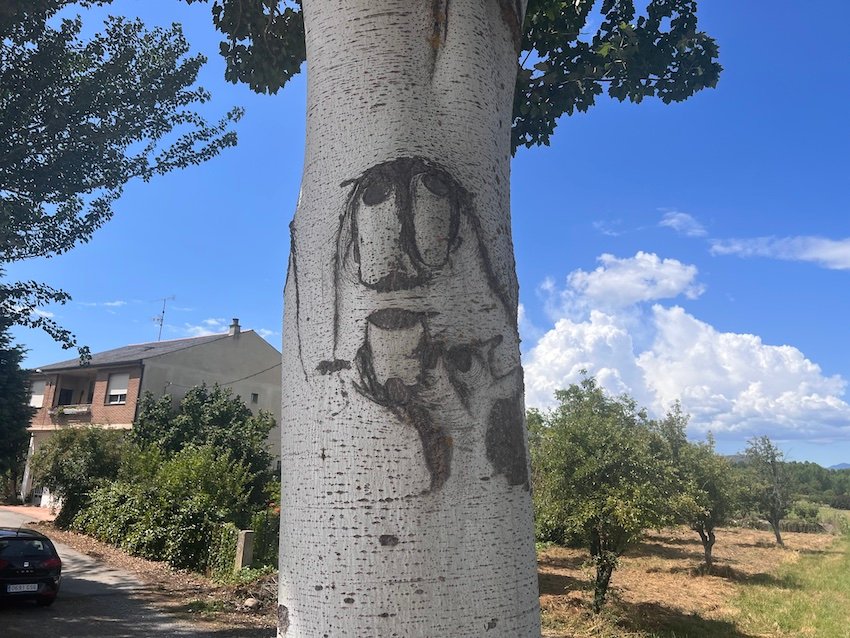

I get to my accommodations at the lovely Albergue el Castillo at 6:30pm, shower and spend about an hour with my legs elevated up against the wall to try to reduce the swelling in my shin.
I finally drag myself out of bed to grab some food in town. I manage to limp to the closest restaurant and have a meal of Seafood Tagliatelle. It’s delicious and I’m starving.
I’m determined to get to bed early tonight. There are blankets in the room and I pile two on top of each other so I can sleep with my feet elevated above my heart – which is supposed to help with healing shin splints (which is what I suspect I have).

Day 27: Villafranca del Bierzo to La Faba
23KM
7:45am – 4:45pm (2.5 hour break)
One of the worst sections of the Camino I have encountered thus far in terms of the amount of highway walking. 90% of the camino today is next to the highway or next to a major road. Thankfully most of the highway sections at least include a concrete barrier between pilgrims and the rush of highway traffic, but there were sections where the Camino is just a small shoulder with nothing shielding walkers from the highway traffic – including almost the immediate 2KM out of Villafranca and it is quite scary.
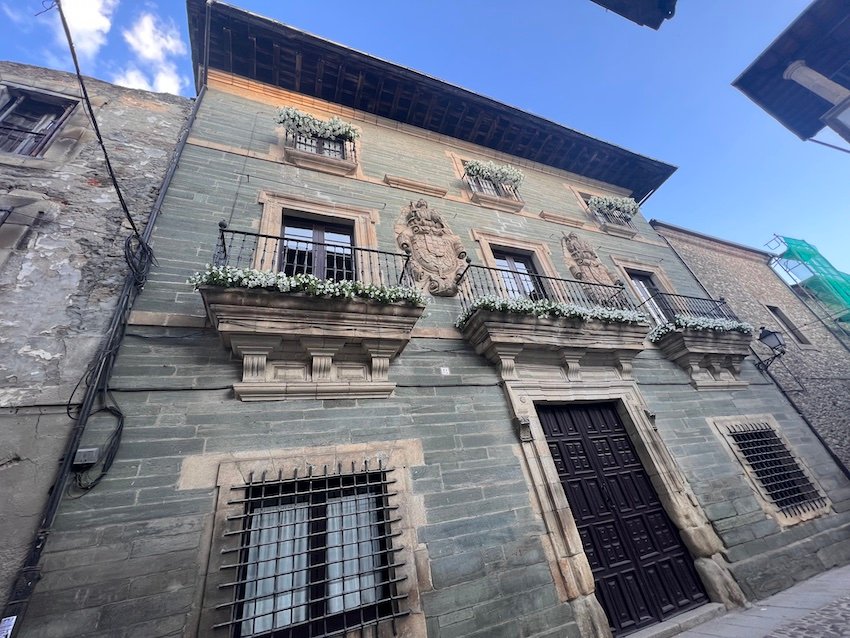
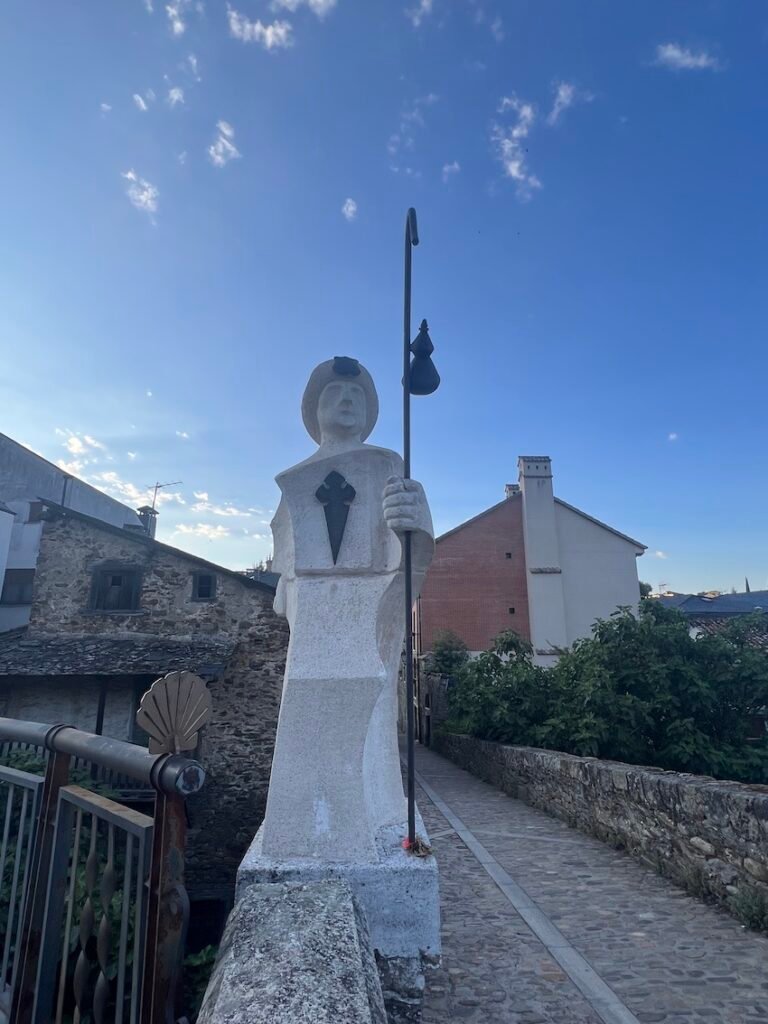
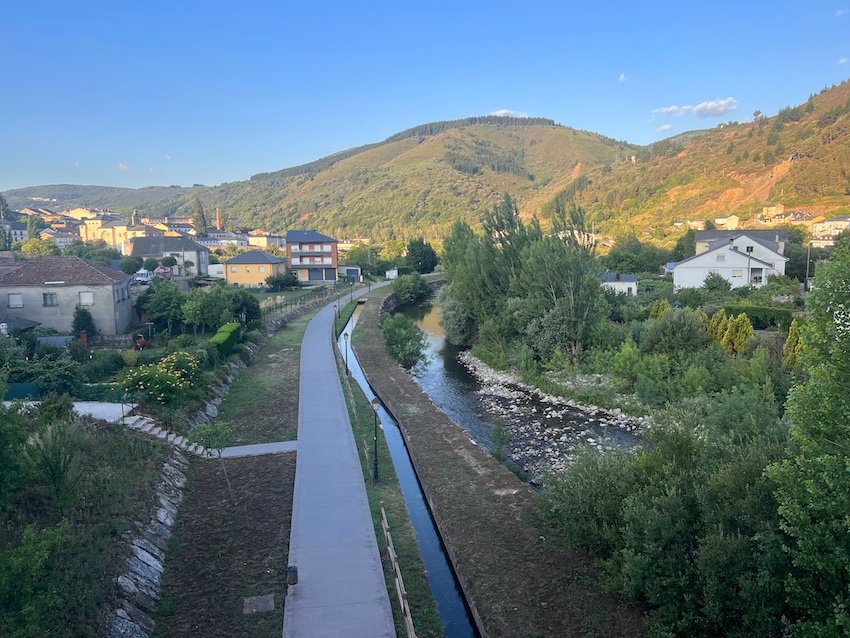
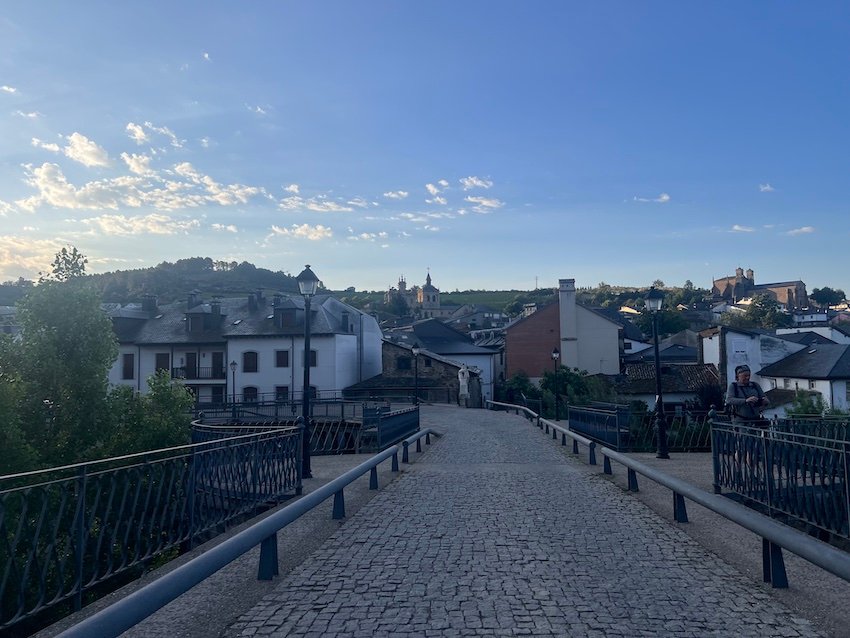
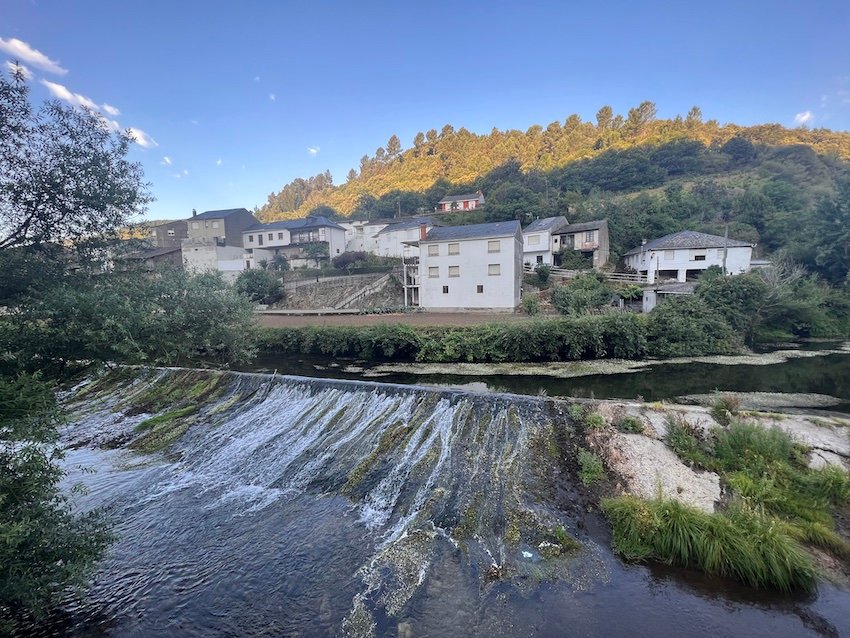
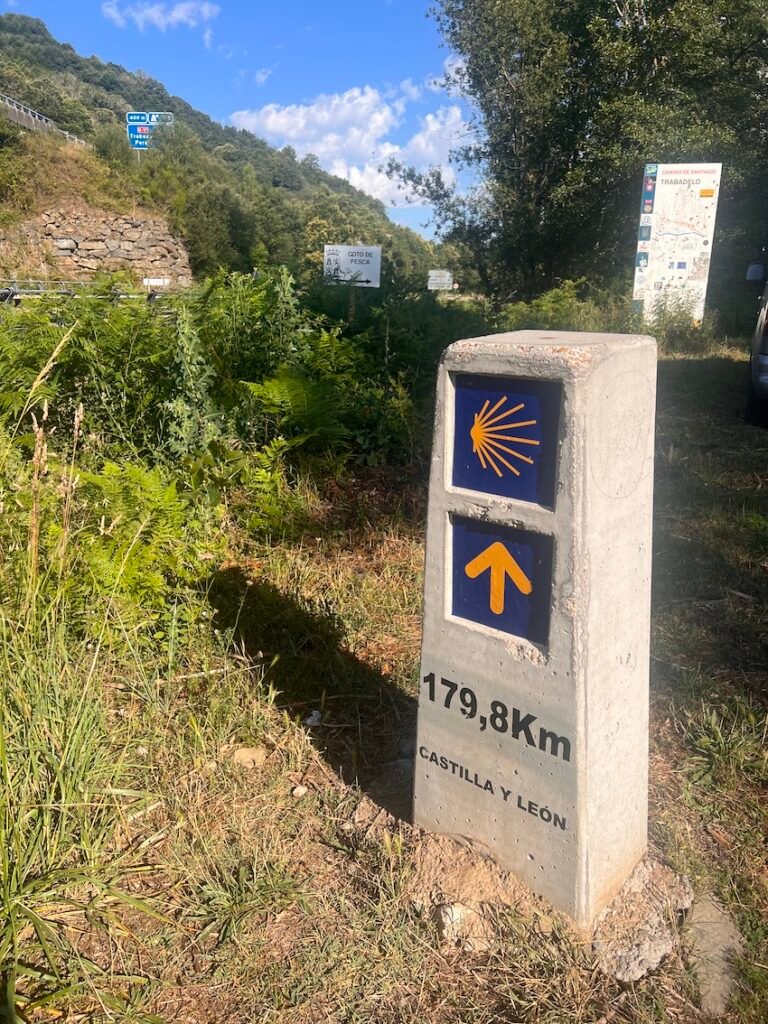
It’s a pretty hair-raising walk unprotected on the side of the road until about 2-3KM before getting into La Faba, where the Camino splits off from the main road onto a beautiful forested dirt trail. But then the climb begins. The route to La Faba is part of the main climb to the peak of O Cebreiro, which is one of the highest points of the Camino. The climb is arduous, but after 20KM of walking next to a highway, I find this part of the day’s hike to be unquestionably the most rewarding despite it’s relentless uphill nature.
I get into La Faba around 4:45pm. La Faba is a beautiful little village about 2km up the 6KM climb to O Cebeiro. The town has only one restaurant/bar: Tito’s Restaurant & Rooms, and it is also where I have a reservation for the night. I meet the Tito the owner of the establishment who also checks me in. When he sees my Canadian passport, his face lights up, and he tells me that he lived in Calgary and Edmonton for a time working in the construction industry.
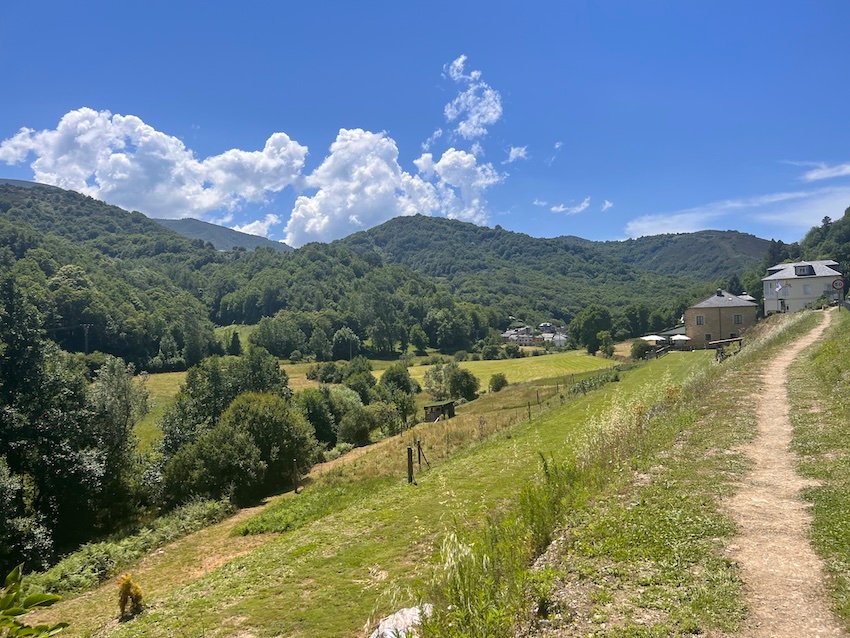

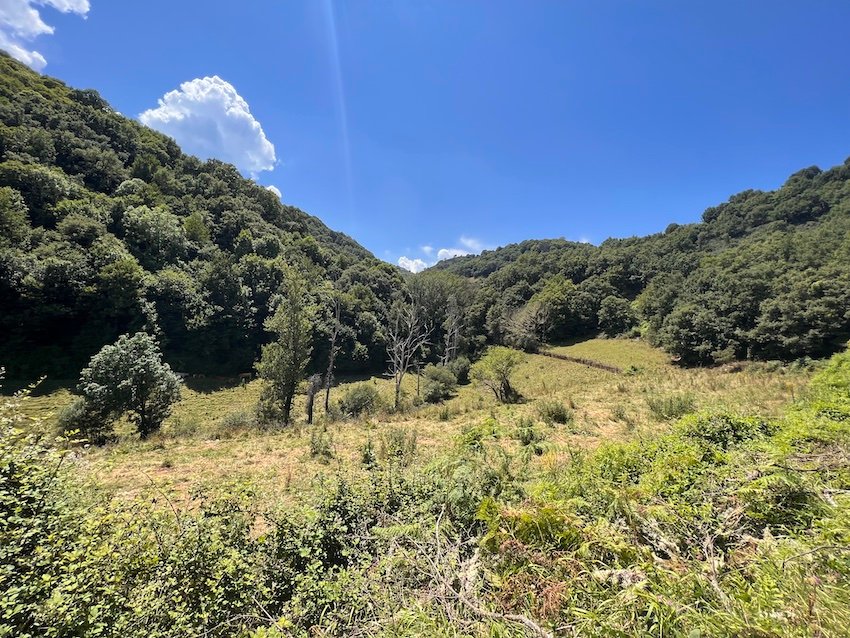
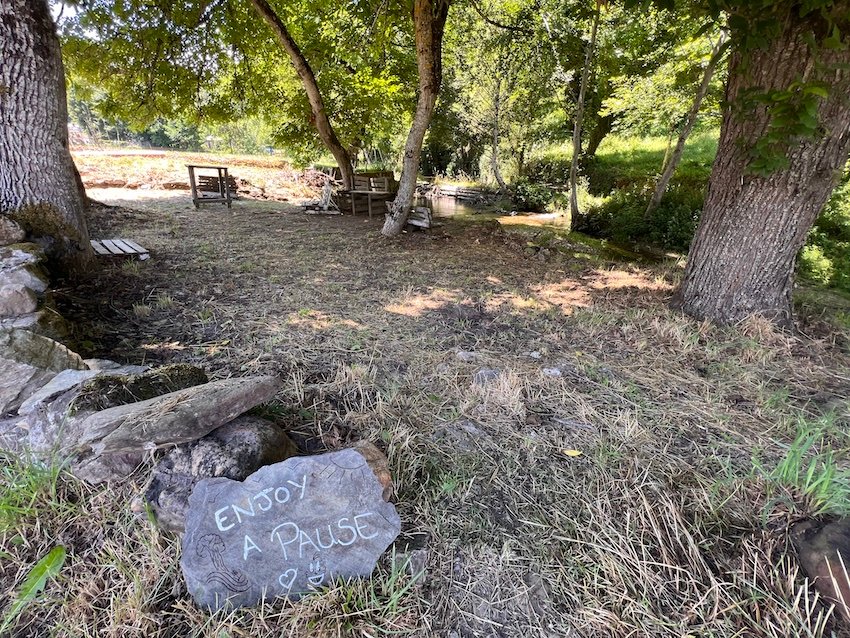
Day 28: La Faba to Triacastela
26KM
8:00am – 5:45pm (3 hour break)
I enjoy a quiet morning at Tito’s albergue as all the other guests left before 7am. I order a cafe con leche and chocolate croissant from Tito, and he approves of my choice as the chocolate croissants were just freshly baked. After breakfast I say goodbye and give my best wishes to Tito before heading out, and enjoy the cool morning breeze in the town before the Camino takes me into a gorgeous forested trail. Although the trail immediately starts uphill, the chocolate croissant and coffee seemed to have given me a jetpack, as I hike up the hills as if the trail were flat, passing a number of hikers on the trail. It was so nice to be on a forest trail, and also nice not to be on flat asphalt anymore. My shin injury seems to have healed significantly.
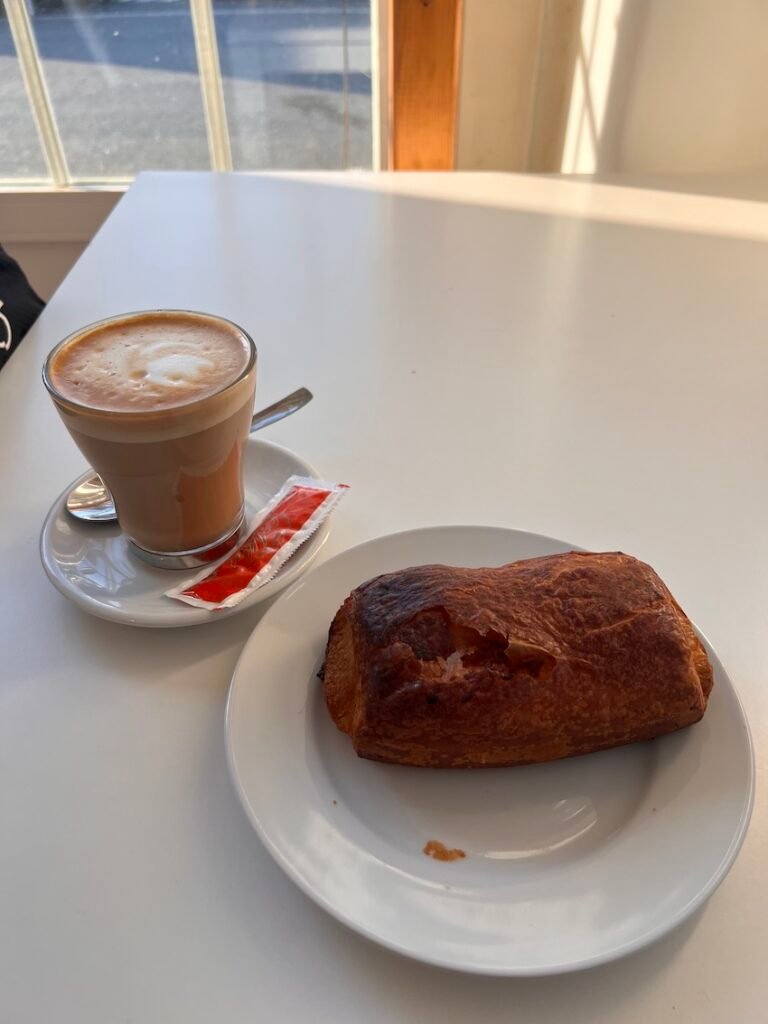
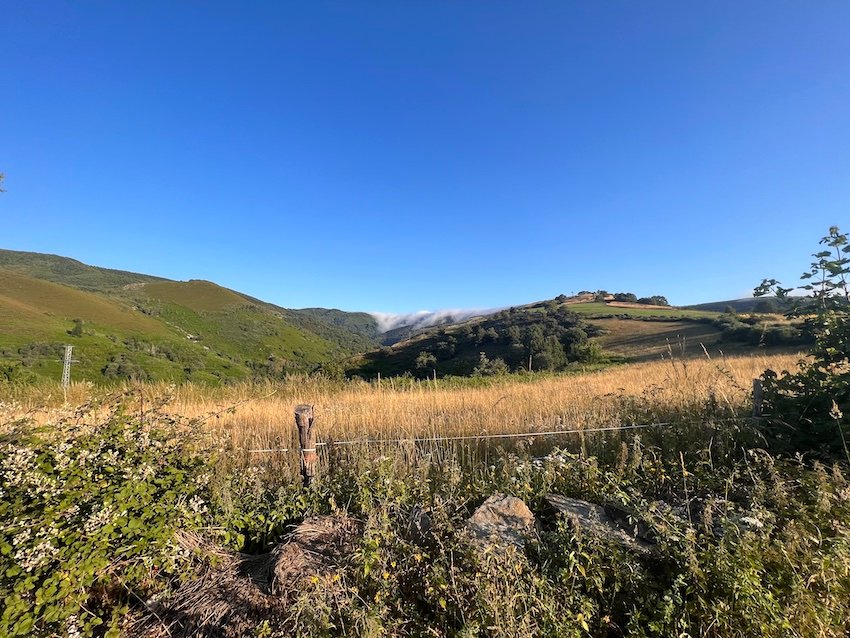
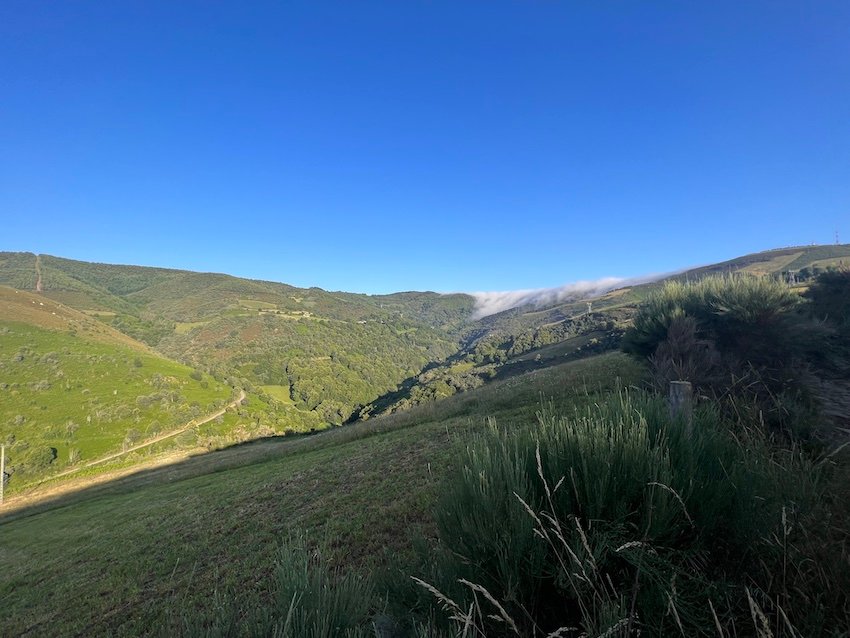
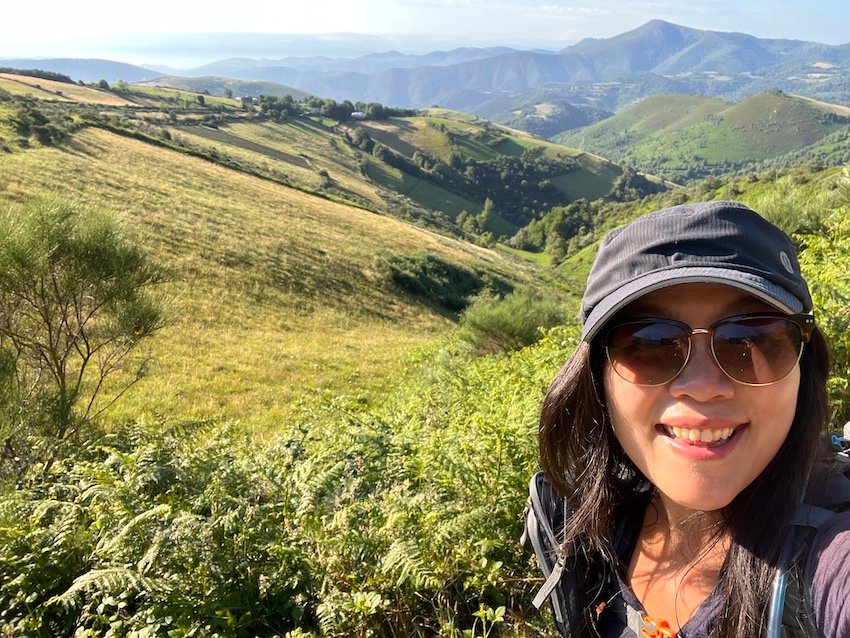
Today I finally cross the border between Leon and Galicia. The scenery seems to change immediately as I cross into Galicia. A thick high mountain mist seems to instantly surround me, lending an air of haunting mysticism to the forested trail that seemed so cheery in the sunshine just moments earlier in the province of Leon.
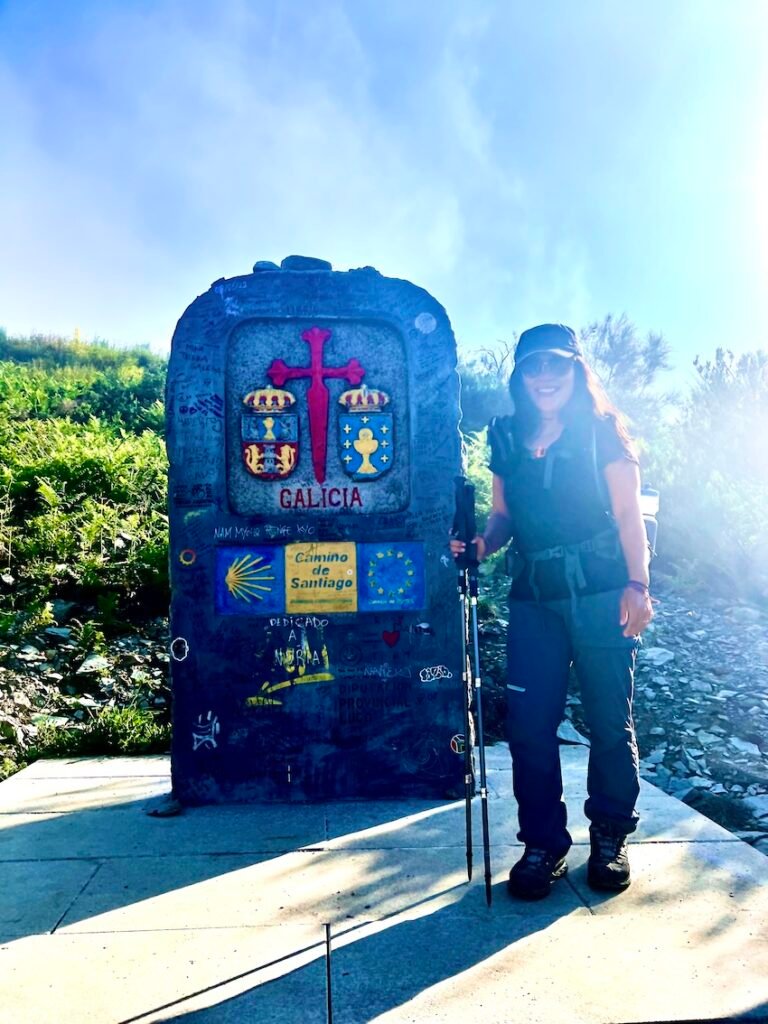
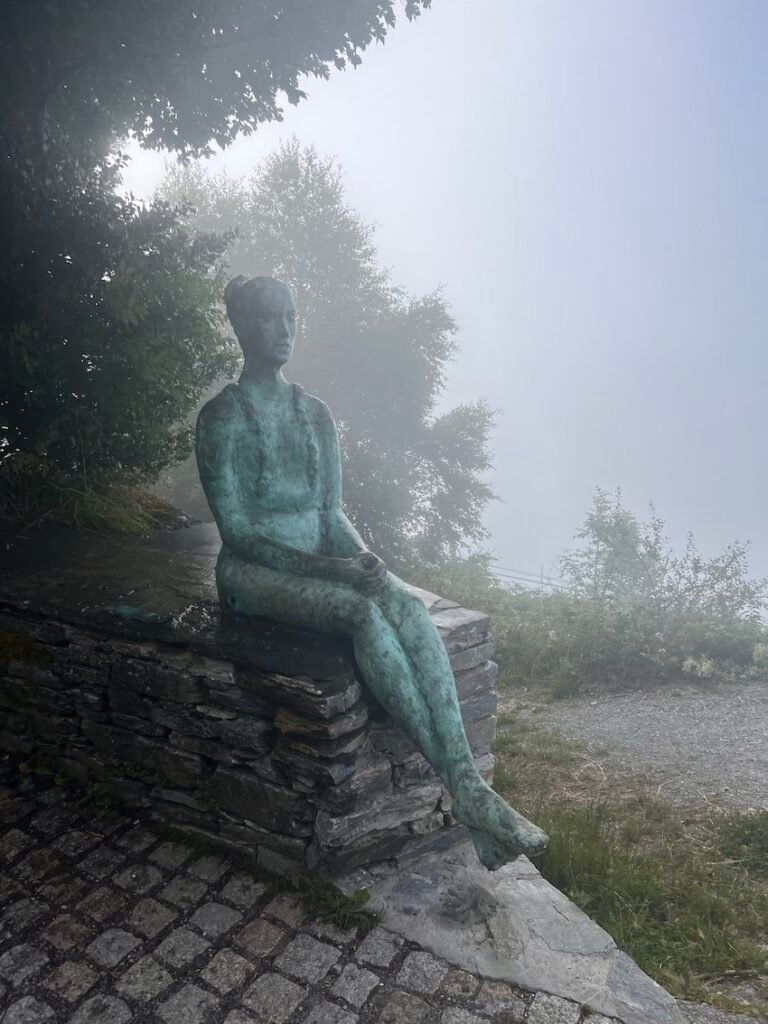
I immediately feel the ancient Celtic heritage that is uniquely Galician as I enter the town of O Cebreiro. Music featuring the Galician bagpipes permeates around the town centre, and the thick morning mist that still shrouds the town and its stone buildings makes you forget that you’re actually in Spain. Signs are in the local language of Gallego – a language more similar to Portuguese than Spanish. This place is unlike any other place I’ve visited in Spain – and certainly unique in the world with the tricultural influences of Spanish, Portuguese and Celtic.
While the trail leading of O Cebreiro is net downhill, the rest of the trail features rolling terrain and some climbs that rival those of the Pyrenees. The climb into the town of Alto do Poio, is one of the steepest I have encountered anywhere on the Camino – possibly steeper than anything I climbed that first day across the Pyreness. A restaurant/albergue is perfectly situated right at the top of the hill. No one resists the siren-song of food, drink and an inviting patio with beautiful white sun umbrellas after the climb.
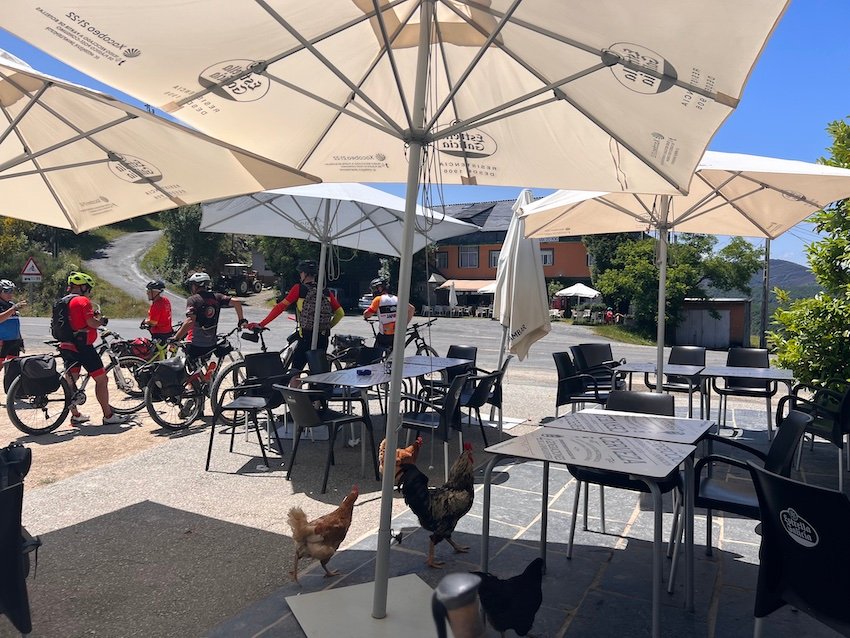
The school group arrives after me, as I am enjoying a delicious lunch at the restaurant, and I see the owner run over with an ice-cream billboard that he strategically places right at the top of the hill so all the kids see the kinds of ice-cream on offer at the restaurant – which literally nets the restaurant 25 customers instantly. If you could resist the ice-cream billboard, the restaurant also has two absolutely adorable puppies running around to melt the hearts of even the most stubborn pilgrim.
What a business model I think as I finally have a first taste of Tarte de Santiago which was included in my 10 Euro Pilgrim menu – I don’t usually eat a meal this big in the middle of the day – but after all that climbing, I am famished. The Tarte de Santiago is good, and as it’s made of almonds, it give me an idea to make a keto-friendly version of it when I get back to Canada.

From Fillobal to Triacastela, the Camino takes a downhill trend again much to the chagrin of my sore feet, but some of the scenery is absolutely lovely. Between villages, the Camino generally weaves into gloriously shaded forest paths, and then onto gravel roads with bucolic pastoral scenes.
At some point I see a herd of large brown jersey cows grazing on a hillside. While calm, the massive cows teeter rather precariously on the slope while grazing, making me wonder as I walk past if I would have an unfortunate “death by cow” incident if one of them were to lose their footing and tumble over the disturbingly fragile looking wire fence as I walk past. I would love to take a photo of the scene, but the whole “death by tumbling cow” potential of the whole scenario makes me walk quickly and camera-lessly past all the cows to the safety of cowless areas.
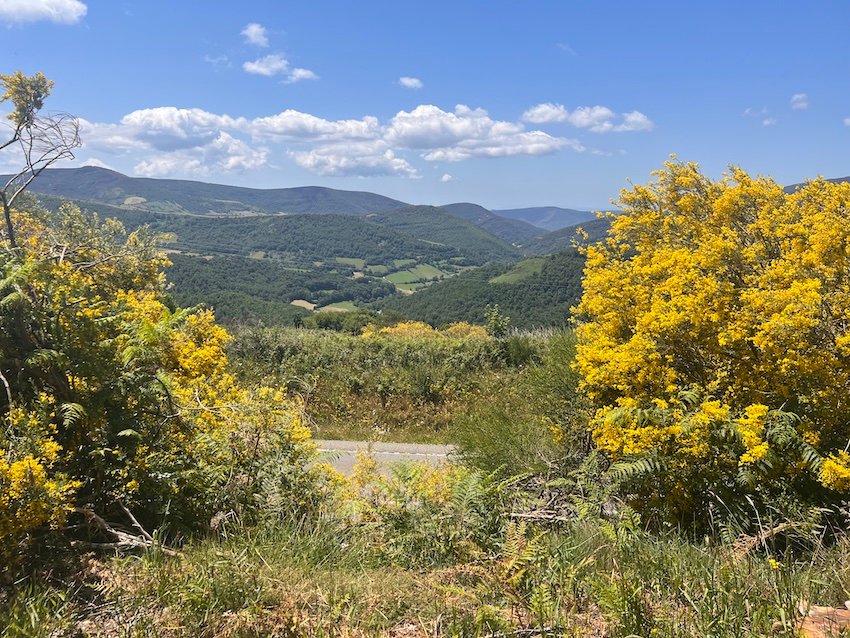
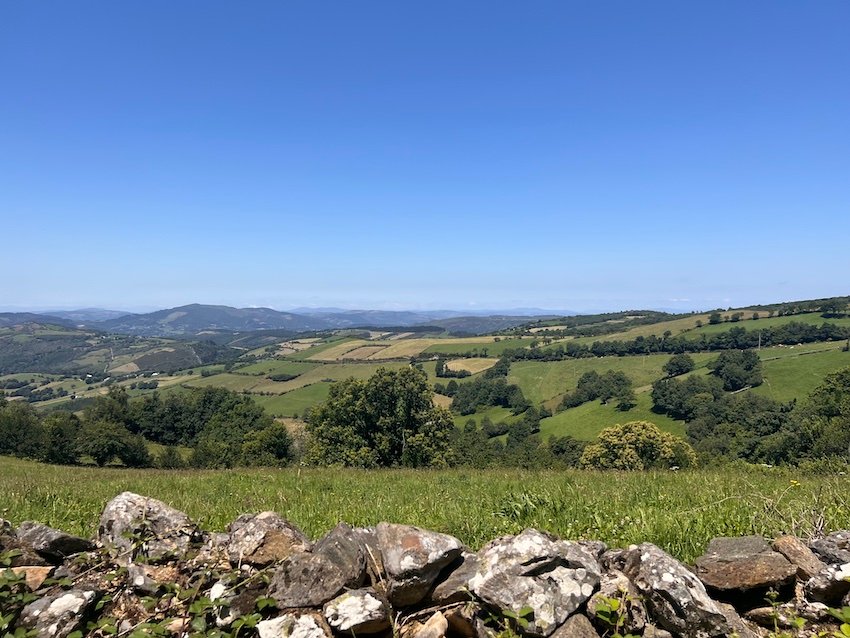

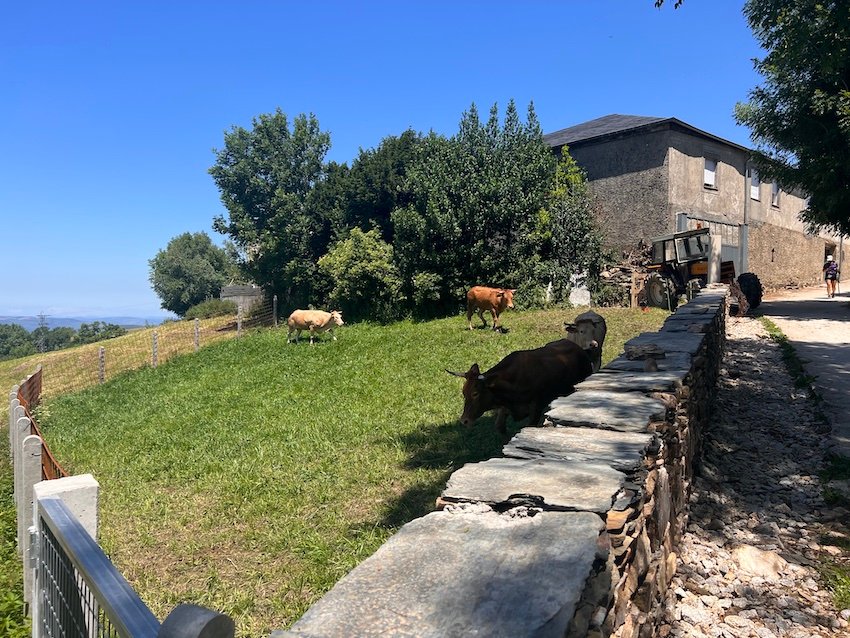
I take a quick rest break at a bar overlooking glorious Galician pastoral life in Fillobal. While checking my messages, I find out that a friend of mine – a young woman from the United States, with whom I hiked during the 1st week on the Camino, has been sidelined by a stress fracture in her foot. Her last stop was Sarria – so aching close to completion, and yet it is only the last 100KM that will allow one to get the Compostela certificate of completion for the Camino de Santiago. I wish her a speedy recovery from her injuries, and hope that she might heal fast enough to continue her journey on the same trip. I’m certain that she will finish the Camino one way or another.

Triacastela a larger town in Galicia that is named after the three castles that used to exist in the area. The town was an important stop for medieval pilgrims, and still is a main stopping point for modern day pilgrims, as it is located approximately at the midpoint between Villafranca del Bierzo and Sarria. I stay at a small private hostel, Albergue Berce do Camino tonight.



I have one of my best set-menu dinners ever on the Camino at the Complexo Xacobeo, where I get a personal-sized platter of seafood paella that is still sizzling straight from the oven; an enormous platter of churrasco a la parrilla (grilled beef and chorizo), dessert, and an entire bottle of wine for the tiny price of 12 Euro! Other pilgrims join me at the restaurant and we have a boisterous wine-filled night before retiring to our respective albergues.
